Applications of Open-Access Remotely Sensed Data for Flood Modelling and Mapping in Developing Regions
Abstract
1. Introduction to Flood Modelling and Mapping
2. Data Limitations, Prediction of Ungauged Basins and Remote Sensing Advancements
3. Open-Access Remotely Sensed Data Sources for Flood Modelling and Management
3.1. Radar Altimetry for Water Level and Elevation Measurements
3.1.1. Altimetry for Discharge Estimation
3.1.2. Altimetry for Digital Elevation Model Accuracy Assessment
3.1.3. Altimetry for Bathymetry Delineation
3.1.4. Altimetry for Hydrodynamic Model Calibration and Validation
3.2. Open-Access Digital Elevation Model Data and Applications in Flood Modelling
3.3. Open-Access Optical and Radar Satellite Images and Applications in Flood Modelling and Mapping
4. Case Study: Open-Access Remotely Sensed Data Applications in Flood Monitoring and Management in Nigeria
4.1. Hydro-Meteorological Data Limitations in Nigeria
4.2. Remote Sensing for Flood Management in Nigeria
4.3. Applications of Open-Access Remotely Sensed Data for Flood Management in Nigeria
5. Open-Access Remotely Sensed Data in Transboundary Flood Management
5.1. Transboundary Flood Management Nigeria (Niger River Basin)
5.2. Application of Open-Access Remotely Sensed Data in Transboundary Flood Management, Nigeria
6. Providers of Data for Flood Emergency Management
6.1. International Charter “Space and Major Disasters”
6.2. International Water Management Institute Emergency Response Products for Water Disasters
6.3. Copernicus Emergency Management Service
6.4. Digital Globe Open Data Program
7. Synthesis
8. Conclusions
Author Contributions
Funding
Acknowledgments
Conflicts of Interest
References
- Plate, E. Flood risk and flood management. J. Hydrol. 2002, 267, 2–11. [Google Scholar] [CrossRef]
- Merwade, V.; Olivera, F.; Arabi, M.; Edleman, S. Uncertainty in flood inundation mapping: Current issues and future directions. J. Hydrol. Eng. 2008, 13, 608–620. [Google Scholar] [CrossRef]
- Moel, H.; Jongman, B.; Kreibich, H.; Merz, B.; Penning-Rowsell, E.; Ward, P. Flood risk assessments at different spatial scales. Mitig. Adapt. Strateg. Glob. Chang. 2015, 20, 865–890. [Google Scholar] [CrossRef]
- Klijn, F.; Samuels, P.; Van Os, A. Towards flood risk management in the EU: State of affairs with examples from various European countries. Int. J. River Basin Manag. 2008, 6, 307–321. [Google Scholar] [CrossRef]
- Büchele, B.; Kreibich, H.; Kron, A.; Thieken, A.; Ihringer, J.; Oberle, P.; Merz, B.; Nestmann, F. Flood- risk mapping: Contributions towards an enhanced assessment of extreme events and associated risks. Nat. Hazards Earth Syst. Sci. 2006, 6, 485–503. [Google Scholar] [CrossRef]
- Ologunorisa, T.E. An assessment of flood vulnerability zones in the Niger Delta, Nigeria. Int. J. Environ. Stud. 2004, 61, 31–38. [Google Scholar] [CrossRef]
- Valdes, H.M. Living with Risk: A Global Review of Disaster Reduction Initiatives; United Nations Publications: New York, NY, USA, 2004; Volume 1. [Google Scholar]
- Els, Z. Data Availability and Requirements for Flood Hazard Mapping. Master’s Thesis, Natural Sciences at Stellenbosch University, Stellenbosch, South Africa, 2013. [Google Scholar]
- Federal Ministry of Environment. Technical Guidelines on Soil Erosion, Flood and Coastal Zone Management; Federal Ministry of Environment: Abuja, Nigeria, 2005.
- Aerts, J.C.J.H.; Alphen, J.V.; Moel, H.D. Flood maps in Europe-methods, availability and use. Nat. Hazards Earth Syst. Sci. 2009, 9, 289–301. [Google Scholar]
- Martini, F.; Loat, R. Handbook on Good Practices for Flood Mapping in Europe; EXCIMAP: Brussels, Belgium, 2007. [Google Scholar] [CrossRef]
- Awokola, O.; Martins, O. Regional Flood Frequency Analysis of Osun Drainage Basin, South-Western Nigeria. Niger. J. Sci. 2001, 35, 37–44. [Google Scholar]
- Kjeldsen, T.R.; Smithers, J.C.; Schulze, R.E. Regional flood frequency analysis in the KwaZulu- Natal province, South Africa, using the index- flood method. J. Hydrol. 2002, 255, 194–211. [Google Scholar] [CrossRef]
- Leclerc, M.; Ouarda, T.B.M.J. Non- stationary regional flood frequency analysis at ungauged sites. J. Hydrol. 2007, 343, 254–265. [Google Scholar] [CrossRef]
- Ahn, J.; Cho, W.; Kim, T.; Shin, H.; Heo, J.-H. Flood frequency analysis for the annual peak flows simulated by an event-based rainfall-runoff model in an urban drainage basin. Water 2014, 6, 3841–3863. [Google Scholar] [CrossRef]
- Sarhadi, A.; Soltani, S.; Modarres, R. Probabilistic flood inundation mapping of ungauged rivers: Linking GIS techniques and frequency analysis. J. Hydrol. 2012, 458–459, 68–86. [Google Scholar] [CrossRef]
- Di Baldassarre, G.; Schumann, G.; Bates, P.; Freer, J.; Beven, K. Flood- plain mapping: A critical discussion of deterministic and probabilistic approaches. Hydrol. Sci. J. 2010, 55, 364–376. [Google Scholar] [CrossRef]
- Muncaster, S.; Warwick, B.; McCowab, A. Design flood estimation in small catchments using two dimensional hydraulic modelling—A case study. In Hydrology and Water Resource Symposium; TAS: Launceston, Australia, 2006; pp. 104–109. [Google Scholar]
- Neal, J.; Schumann, G.; Fewtrell, T.; Budimir, M.; Bates, P.; Mason, D. Evaluating a new LISFLOOD-FP formulation with data from the summer 2007 floods in Tewkesbury, UK. J. Flood Risk Manag. 2011, 4, 88–95. [Google Scholar] [CrossRef]
- Taubenböck, H.; Wurm, M.; Netzband, M.; Zwenzner, H.; Roth, A.; Rahman, A.; Dech, S. Flood risks in urbanized areas—Multi- sensoral approaches using remotely sensed data for risk assessment. Nat. Hazards Earth Syst. Sci. 2011, 11, 431–444. [Google Scholar] [CrossRef]
- Eyers, R.; Obowu, C.; Lasisi, B. Niger Delta Flooding: Monitoring, Forecasting & Emergency Response Support from SPDC. In Proceedings of the FIG Working Week, Environment and Sustainability, Abuja, Nigeria, 6–10 May 2013. [Google Scholar]
- Nigeria Hydrological Services Agency; Ankle Foot Orthosis. Nigerian Hydrological Service Agency, 2014 Annual Flood Outlook (AFO); NIHSA: Sioux City, IA, USA, 2014. [Google Scholar]
- Olayinka, D.N.; Nwilo, P.C.; Emmanuel, A. From Catchment to Reach: Predictive Modelling of Floods in Nigeria. In Proceedings of the FIG Working Week, Environment for Sustainability, Abuja, Nigeria, 6–10 May 2013. [Google Scholar]
- Maxwell, O. Hydrological Data Banking for Sustainable Development in Nigeria: An Overview. Aceh Int. J. Sci. Technol. 2013, 2, 59–62. [Google Scholar] [CrossRef]
- Ekeu-wei, I.T. Evaluation of Hydrological Data Collection Challenges and Flood Estimation Uncertainties in Nigeria. Environ. Nat. Resour. Res. 2018, 8, 44–54. [Google Scholar] [CrossRef]
- Sivapalan, M. Prediction in ungauged basins: A grand challenge for theoretical hydrology. Hydrol. Process. 2003, 17, 3163–3170. [Google Scholar] [CrossRef]
- Sivapalan, M.; Takeuchi, K.; Franks, S.W.; Gupta, V.K.; Karambiri, H.; Lakshmi, V.; Liang, X.; McDonnell, J.J.; Mendiondo, E.M.; Connell, P.E.; et al. IAHS Decade on Predictions in Ungauged Basins (PUB), 2003–2012: Shaping an exciting future for the hydrological sciences. Hydrol. Sci. J. 2003, 48, 857–880. [Google Scholar] [CrossRef]
- Hrachowitz, M.; Savenije, H.; Blöschl, G.; McDonnell, J.; Sivapalan, M.; Pomeroy, J.; Arheimer, B.; Blume, T.; Clark, M.; Ehret, U. A decade of Predictions in Ungauged Basins (PUB)—A review. Hydrol. Sci. J. 2013, 58, 1198–1255. [Google Scholar] [CrossRef]
- Yan, K.; Di Baldassarre, G.; Solomatine, D.P.; Schumann, G.J.P. A review of low-cost space-borne data for flood modelling: Topography, flood extent and water level. Hydrol. Process. 2015, 29, 3368–3387. [Google Scholar] [CrossRef]
- Schumann, G.; Bates, P.D.; Horritt, M.S.; Matgen, P.; Pappenberger, F. Progress in integration of remote sensing- derived flood extent and stage data and hydraulic models. Rev. Geophys. 2009, 47. [Google Scholar] [CrossRef]
- Mason, D.C.; Schumann, G.; Bates, P. Data utilization in flood inundation modelling. Flood Risk Sci. Manag. 2011. [Google Scholar] [CrossRef]
- Dano Umar, L.; Abdul-Nasir, M.; Ahmad Mustafa, H.; Imtiaz Ahmed, C.; Soheil, S.; Abdul-Lateef, B.; Haruna Ahmed, A. Geographic Information System and Remote Sensing Applications in Flood Hazards Management: A Review. Res. J. Appl. Sci. Eng. Technol. 2011, 3, 933–947. [Google Scholar]
- Maswood, M.; Hossain, F. Advancing river modelling in ungauged basins using satellite remote sensing: The case of the Ganges- Brahmaputra- Meghna basin. Int. J. River Basin Manag. 2016, 14, 103–117. [Google Scholar] [CrossRef]
- Alsdorf, D.E.; Rodríguez, E.; Lettenmaier, D.P. Measuring surface water from space. Rev. Geophys. 2007, 45, RG2002. [Google Scholar] [CrossRef]
- Koblinsky, C.; Clarke, R.; Brenner, A.; Frey, H. Measurement of river level variations with satellite altimetry. Water Resour. Res. 1993, 29, 1839–1848. [Google Scholar] [CrossRef]
- Da Silva, J.S.; Calmant, S.; Seyler, F.; Rotunno Filho, O.C.; Cochonneau, G.; Mansur, W.J. Water levels in the Amazon basin derived from the ERS 2 and ENVISAT radar altimetry missions. Remote Sens. Environ. 2010, 114, 2160–2181. [Google Scholar] [CrossRef]
- Sulistioadi, Y.B.; Tseng, K.H.; Shum, C.K.; Hidayat, H.; Sumaryono, M.; Suhardiman, A.; Setiawan, F.; Sunarso, S. Satellite radar altimetry for monitoring small rivers and lakes in Indonesia. Hydrol. Earth Syst. Sci. 2015, 19, 341–359. [Google Scholar] [CrossRef]
- Belaud, G.; Cassan, L.; Bader, J.; Bercher, N.; Feret, T. Calibration of a propagation model in large river using satellite altimetry. In Proceedings of the 6th International Symposium on Environmental Hydraulics, Athens, Greece, 23–25 June 2010; pp. 23–25. [Google Scholar]
- Birkinshaw, S.J.; Moore, P.; Kilsby, C.G.; Donnell, G.M.; Hardy, A.J.; Berry, P.A.M. Daily discharge estimation at ungauged river sites using remote sensing. Hydrol. Process. 2014, 28, 1043–1054. [Google Scholar] [CrossRef]
- Musa, Z.; Popescu, I.; Mynett, A. A review of applications of satellite SAR, optical, altimetry and DEM data for surface water modelling, mapping and parameter estimation. Hydrol. Earth Syst. Sci. Discuss. 2015, 12, 4857–4878. [Google Scholar] [CrossRef]
- Crétaux, J.-F.; Jelinski, W.; Calmant, S.; Kouraev, A.; Vuglinski, V.; Bergé-Nguyen, M.; Gennero, M.-C.; Nino, F.; Del Rio, R.A.; Cazenave, A. SOLS: A lake database to monitor in the Near Real Time water level and storage variations from remote sensing data. Adv. Space Res. 2011, 47, 1497–1507. [Google Scholar] [CrossRef]
- Sun, W.; Ishidaira, H.; Bastola, S. Calibration of hydrological models in ungauged basins based on satellite radar altimetry observations of river water level. Hydrol. Process. 2012, 26, 3524–3537. [Google Scholar] [CrossRef]
- O’Loughlin, F.E.; Neal, J.; Yamazaki, D.; Bates, P.D. ICESat-derived inland water surface spot heights. Water Resour. Res. 2016, 52, 3276–3284. [Google Scholar] [CrossRef]
- Birkett, C.M. The contribution of TOPEX/POSEIDON to the global monitoring of climatically sensitive lakes. J. Geophys. Res. Oceans 1995, 100, 25179–25204. [Google Scholar] [CrossRef]
- Birkett, C.M.; Mertes, L.A.K.; Dunne, T.; Costa, M.H.; Jasinski, M.J. Surface water dynamics in the Amazon Basin: Application of satellite radar altimetry. J. Geophys. Res. Atmos. 2002, 107, LBA 26-1–LBA 26-21. [Google Scholar] [CrossRef]
- Frappart, F.; Calmant, S.; Cauhopé, M.; Seyler, F.; Cazenave, A. Preliminary results of ENVISAT RA- 2- derived water levels validation over the Amazon basin. Remote Sens. Environ. 2006, 100, 252–264. [Google Scholar] [CrossRef]
- Birkinshaw, S.J.; Donnell, G.M.; Moore, P.; Kilsby, C.G.; Fowler, H.J.; Berry, P.A.M. Using satellite altimetry data to augment flow estimation techniques on the Mekong River. Hydrol. Process. 2010, 24, 3811–3825. [Google Scholar] [CrossRef]
- Ponte, R.M.; Wunsch, C.; Stammer, D. Spatial mapping of time-variable errors in Jason-1 and TOPEX/Poseidon sea surface height measurements. J. Atmos. Ocean. Technol. 2007, 24, 1078–1085. [Google Scholar] [CrossRef]
- Chelton, D.B.; Ries, J.C.; Haines, B.J.; Fu, L.-L.; Callahan, P.S. Satellite altimetry. Int. Geophys. 2001, 69, 1–2. [Google Scholar]
- Tourian, M.J.; Tarpanelli, A.; Elmi, O.; Qin, T.; Brocca, L.; Moramarco, T.; Sneeuw, N. Spatiotemporal densification of river water level time series by multimission satellite altimetry. Water Resour. Res. 2016, 52, 1140–1159. [Google Scholar] [CrossRef]
- Pandey, R.; Amarnath, G. The potential of satellite radar altimetry in flood forecasting: Concept and implementation for the Niger-Benue river basin. Proc. IAHS 2015, 370, 223–227. [Google Scholar] [CrossRef]
- Jarihani, A.A.; Callow, J.N.; McVicar, T.R.; Van Niel, T.G.; Larsen, J.R. Satellite- derived Digital Elevation Model (DEM) selection, preparation and correction for hydrodynamic modelling in large, low- gradient and data- sparse catchments. J. Hydrol. 2015, 524, 489–506. [Google Scholar] [CrossRef]
- Urban, T.J.; Schutz, B.E.; Neuenschwander, A.L. A survey of ICESat coastal altimetry applications: Continental Coast, Open Ocean Island, and Inland River. Terr. Atmos. Ocean. Sci. 2008, 19, 1–19. [Google Scholar] [CrossRef]
- Schneider, R.; Godiksen, P.N.; Villadsen, H.; Madsen, H.; Bauer-Gottwein, P. Application of CryoSat- 2 altimetry data for river analysis and modelling. Hydrol. Earth Syst. Sci. Discuss. 2016, 19, 1–19. [Google Scholar] [CrossRef]
- Schwatke, C.; Dettmering, D.; Börgens, E.; Bosch, W. Potential of SARAL/AltiKa for Inland Water Applications. Mar. Geodesy 2015, 38, 626–643. [Google Scholar] [CrossRef]
- European Space Agency. Altimetry Instrument Payload. Available online: https://sentinel.esa.int/web/sentinel/missions/sentinel-3/instrument-payload/altimetry (accessed on 26 April 2016).
- Fu, L.-L.; Alsdorf, D.; Rodriguez, E.; Morrow, R.; Mognard, N.; Lambin, J.; Vaze, P.; Lafon, T. The SWOT (Surface Water and Ocean Topography) mission: Spaceborne radar interferometry for oceanographic and hydrological applications. Proc. Ocean. Obs. 2009, 9, 21–25. [Google Scholar]
- Papa, F.; Durand, F.; Rossow, W.B.; Rahman, A.; Bala, S.K. Satellite altimeter- derived monthly discharge of the Ganga- Brahmaputra River and its seasonal to interannual variations from 1993 to 2008. J. Geophys. Res. Oceans 2010, 115. [Google Scholar] [CrossRef]
- Sridevi, T.; Sharma, R.; Mehra, P.; Prasad, K.V.S.R. Estimating discharge from the Godavari River using ENVISAT, Jason- 2, and SARAL/AltiKa radar altimeters. Remote Sens. Lett. 2016, 7, 348–357. [Google Scholar] [CrossRef]
- Getirana, A.C.V.; Peters-Lidard, C. Estimating water discharge from large radar altimetry datasets. Hydrol. Earth Syst. Sci. 2013, 17, 923–933. [Google Scholar] [CrossRef]
- Tourian, M.; Sneeuw, N.; Bárdossy, A. A quantile function approach to discharge estimation from satellite altimetry (ENVISAT). Water Resour. Res. 2013, 49, 4174–4186. [Google Scholar] [CrossRef]
- Michailovsky, C.I.; McEnnis, S.; Bauer-Gottwein, P.A.M.; Berry, R.; Smith, P. River monitoring from satellite radar altimetry in the Zambezi River basin. Hydrol. Earth Syst. Sci. 2012, 16, 2181–2192. [Google Scholar] [CrossRef]
- Tarpanelli, A.; Amarnath, G.; Brocca, L.; Moramarco, T. Discharge forecasting using MODIS and radar altimetry: Potential application for transboundary flood risk management in Niger-Benue River basin. In Proceedings of the EGU General Assembly Conference Abstracts, Vienna, Austria, 17–22 April 2016. [Google Scholar]
- Sichangi, A.W.; Wang, L.; Yang, K.; Chen, D.; Wang, Z.; Li, X.; Zhou, J.; Liu, W.; Kuria, D. Estimating continental river basin discharges using multiple remote sensing data sets. Remote Sens. Environ. 2016, 179, 36–53. [Google Scholar] [CrossRef]
- Casas, A.; Benito, G.; Thorndycraft, V.R.; Rico, M. The topographic data source of digital terrain models as a key element in the accuracy of hydraulic flood modelling. Earth Surf. Process. Landf. 2006, 31, 444–456. [Google Scholar] [CrossRef]
- Cook, A.; Merwade, V. Effect of topographic data, geometric configuration and modeling approach on flood inundation mapping. J. Hydrol. 2009, 377, 131–142. [Google Scholar] [CrossRef]
- Patro, S.; Chatterjee, C.; Singh, R.; Raghuwanshi, N. Hydrodynamic modelling of a large flood-prone river system in India with limited data. Hydrol. Process. 2009, 23, 2774–2791. [Google Scholar] [CrossRef]
- Wang, W.; Yang, X.; Yao, T. Evaluation of ASTER GDEM and SRTM and their suitability in hydraulic modelling of a glacial lake outburst flood in southeast Tibet. Hydrol. Process. 2012, 26, 213–225. [Google Scholar] [CrossRef]
- Sanyal, J.; Carbonneau, P.; Densmore, A. Hydraulic routing of extreme floods in a large ungauged river and the estimation of associated uncertainties: A case study of the Damodar River, India. Nat. Hazards 2013, 66, 1153–1177. [Google Scholar] [CrossRef]
- Ullah, S.; Farooq, M.; Sarwar, T.; Tareen, M.; Wahid, M. Flood modeling and simulations using hydrodynamic model and ASTER DEM—A case study of Kalpani River. Arab. J. Geosci. 2016, 9, 1–11. [Google Scholar] [CrossRef]
- Amans, O.C.; Beiping, W.; Ziggah, Y.Y. Assessing Vertical Accuracy of SRTM Ver. 4.1 and ASTER GDEM Ver. 2 using Differential GPS Measurements–case study in Ondo State, Nigeria. Int. J. Sci. Eng. Res. 2013, 4, 523–531. [Google Scholar]
- Isioye, O.A.; Yang, I.C. Comparison and validation of ASTER-GDEM and SRTM elevation models over parts of Kaduna State, Nigeria. SASGI Proc. 2013, 1, 1–11. [Google Scholar]
- Zwally, H.J.; Schutz, B.; Abdalati, W.; Abshire, J.; Bentley, C.; Brenner, A.; Bufton, J.; Dezio, J.; Hancock, D.; Harding, D.; et al. ICESat’s laser measurements of polar ice, atmosphere, ocean, and land. J. Geodyn. 2002, 34, 405–445. [Google Scholar] [CrossRef]
- Fricker, H.A.; Borsa, A.; Minster, B.; Carabajal, C.; Quinn, K.; Bills, B. Assessment of ICESat performance at the salar de Uyuni, Bolivia. Geophys. Res. Lett. 2005, 32. [Google Scholar] [CrossRef]
- Jean Stéphane, B.; Hani, A.; Nicolas, L.; Nicolas, B. The Relevance of GLAS/ICESat Elevation Data for the Monitoring of River Networks. Remote Sens. 2011, 3, 708–720. [Google Scholar]
- Satgé, F.; Bonnet, M.P.; Timouk, F.; Calmant, S.; Pillco, R.; Molina, J.; Lavado-Casimiro, W.; Arsen, A.; Crétaux, J.F.; Garnier, J. Accuracy assessment of SRTM v4 and ASTER GDEM v2 over the Altiplano watershed using ICESat/GLAS data. Int. J. Remote Sens. 2015, 36, 465–488. [Google Scholar] [CrossRef]
- Carabajal, C.C.; Harding, D.J. ICESat validation of SRTM C-band digital elevation models. Geophys. Res. Lett. 2005, 32, 117–137. [Google Scholar] [CrossRef]
- Kon Joon Bhang, F.W.; Schwartz, A.; Braun, A. Verification of the Vertical Error in C- Band SRTM DEM Using ICESat and Landsat- 7, Otter Tail County, MN. IEEE Trans. Geosci. Remote Sens. 2007, 45, 36–44. [Google Scholar] [CrossRef]
- Du, X.; Guo, H.; Fan, X.; Zhu, J.; Yan, Z.; Zhan, Q. Vertical accuracy assessment of freely available digital elevation models over low-lying coastal plains. Int. J. Dig. Earth 2016, 9, 252–271. [Google Scholar] [CrossRef]
- Zhao, G.; Xue, H.; Ling, F. Assessment of ASTER GDEM performance by comparing with SRTM and ICESat/GLAS data in Central China. In Proceedings of the 18th International Conference on Geoinformatics, Beijing, China, 18–20 June 2010; pp. 1–5. [Google Scholar]
- Braun, A.; Fotopoulos, G. Assessment of SRTM, ICESat, and survey control monument elevations in Canada. Photogramm. Eng. Remote Sens. 2007, 73, 1333–1342. [Google Scholar] [CrossRef]
- Rastogi, G.; Agrawal, R.; Ajai, R. Bias corrections of CartoDEM using ICESat- GLAS data in hilly regions. GISci. Remote Sens. 2015, 52, 571–585. [Google Scholar]
- Beaulieu, A.; Clavet, D. Accuracy assessment of Canadian digital elevation data using ICESat. Photogramm. Eng. Remote Sens. 2009, 75, 81–86. [Google Scholar] [CrossRef]
- Yamanokuchi, T.; Doi, K.; Shibuya, K. Comparison of Antarctic Ice Sheet Elevation between ICESat GLAS and InSAR DEM. In Proceedings of the 2006 IEEE International Symposium on Geoscience and Remote Sensing, Denver, CO, USA, 31 July–4 August 2006; pp. 2712–2715. [Google Scholar]
- Mirzaee, S.; Motagh, M.; Arefi, H. Assessment of Reference Height Models on Quality of Tandem-X dem. Int. Arch. Photogramm. Remote Sens. Spat. Inf. Sci. 2015, 40, 463–466. [Google Scholar] [CrossRef]
- Sampson, C.C.; Smith, A.M.; Bates, P.D.; Neal, J.C.; Alfieri, L.; Freer, J.E. A high- resolution global flood hazard model. Water Resour. Res. 2015, 51, 7358–7381. [Google Scholar] [CrossRef] [PubMed]
- O’Loughlin, F.; Paiva, R.; Durand, M.; Alsdorf, D.; Bates, P. Development of a ‘bare-earth’ SRTM DEM product. In Proceedings of the EGU General Assembly Conference Abstracts, Vienna, Austria, 12–17 April 2015. [Google Scholar]
- Heyder, U. Vertical Forest Structure from ICESat/GLAS Lidar Data. Master’s Thesis, Department of Geography, University College London, London, UK, 2005; pp. 12–50. [Google Scholar]
- Trigg, M.A.; Bates, P.D.; Wilson, M.D.; Horritt, M.S.; Alsdorf, D.E.; Forsberg, B.R.; Vega, M.C. Amazon flood wave hydraulics. J. Hydrol. 2009, 374, 92–105. [Google Scholar] [CrossRef]
- Chávarri, E.; Crave, A.; Bonnet, M.-P.; Mejía, A.; Santos Da Silva, J.; Guyot, J.L. Hydrodynamic modelling of the Amazon River: Factors of uncertainty. J. S. Am. Earth Sci. 2013, 44, 94–103. [Google Scholar] [CrossRef]
- Bates, P.; Neal, J.; Alsdorf, D.; Schumann, G. Observing Global Surface Water Flood Dynamics. Surv. Geophys. 2014, 35, 839–852. [Google Scholar] [CrossRef]
- Durand, M.; Andreadis, K.M.; Alsdorf, D.E.; Lettenmaier, D.P.; Moller, D.; Wilson, M. Estimation of bathymetric depth and slope from data assimilation of swath altimetry into a hydrodynamic model. Geophys. Res. Lett. 2008, 35. [Google Scholar] [CrossRef]
- Bates, P.D.; De Roo, A.P.J. A simple raster-based model for flood inundation simulation. J. Hydrol. 2000, 236, 54–77. [Google Scholar] [CrossRef]
- Yoon, Y.; Durand, M.; Merry, C.J.; Clark, E.A.; Andreadis, K.M.; Alsdorf, D.E. Estimating river bathymetry from data assimilation of synthetic SWOT measurements. J. Hydrol. 2012, 464–465, 363–375. [Google Scholar] [CrossRef]
- Van Wesemael, A.; Gobeyn, S.; Neal, J.; Lievens, H.; Van Eerdenbrugh, K.; De Vleeschouwer, N.; Schumann, G.; Vernieuwe, H.; Di Baldassarre, G.; De Baets, B. Calibration of a flood inundation model using a SAR image: Influence of acquisition time. In Proceedings of the EGU General Assembly Conference Abstracts, Vienna, Austria, 17–22 April 2016. [Google Scholar]
- Neal, J.C.; Odoni, N.A.; Trigg, M.A.; Freer, J.E.; Garcia-Pintado, J.; Mason, D.C.; Wood, M.; Bates, P.D. Efficient incorporation of channel cross-section geometry uncertainty into regional and global scale flood inundation models. J. Hydrol. 2015, 529, 169–183. [Google Scholar] [CrossRef]
- Stephens, E.; Schumann, G.; Bates, P. Problems with binary pattern measures for flood model evaluation. Hydrol. Process. 2014, 28, 4928–4937. [Google Scholar] [CrossRef]
- Jung, H.C.; Jasinski, M.; Kim, J.W.; Shum, C.K.; Bates, P.; Neal, J.; Lee, H.; Alsdorf, D. Calibration of two- dimensional floodplain modeling in the central Atchafalaya Basin Floodway System using SAR interferometry. Water Resour. Res. 2012, 48. [Google Scholar] [CrossRef]
- Dung, N.V.; Merz, B.; Bárdossy, A.; Thang, T.D.; Apel, H. Multi- objective automatic calibration of hydrodynamic models utilizing inundation maps and gauge data. Hydrol. Earth Syst. Sci. 2011, 15, 1339–1354. [Google Scholar] [CrossRef]
- Pasquale, N.; Perona, P.; Wombacher, A.; Burlando, P. Hydrodynamic model calibration from pattern recognition of non- orthorectified terrestrial photographs. Comput. Geosci. 2014, 62, 160–167. [Google Scholar] [CrossRef]
- Wood, M.; Neal, J.; Hostache, R.; Corato, G.; Bates, P.; Giustarini, L.; Chini, M.; Matgen, P. Using time series of satellite SAR images to calibrate channel depth and friction parameters in the LISFLOOD-FP hydraulic model. In Proceedings of the EGU General Assembly Conference Abstracts, Vienna, Austria, 27 April–2 May 2014. [Google Scholar]
- Andréfouët, S.; Ouillon, S.; Brinkman, R.; Falter, J.; Douillet, P.; Wolk, F.; Smith, R.; Garen, P.; Martinez, E.; Laurent, V.; et al. Review of solutions for 3D hydrodynamic modeling applied to aquaculture in South Pacific atoll lagoons. Mar. Pollut. Bull. 2006, 52, 1138–1155. [Google Scholar] [CrossRef] [PubMed]
- Domeneghetti, A. On the use of SRTM and altimetry data for flood modeling in data- sparse regions. Water Resour. Res. 2016, 52, 2901–2918. [Google Scholar] [CrossRef]
- Yan, K.; Tarpanelli, A.; Balint, G.; Moramarco, T.; Baldassarre, G.D. Exploring the Potential of SRTM Topography and Radar Altimetry to Support Flood Propagation Modeling: Danube Case Study. J. Hydrol. Eng. 2015, 20, 04014048. [Google Scholar] [CrossRef]
- Domeneghetti, A.; Tarpanelli, A.; Brocca, L.; Barbetta, S.; Moramarco, T.; Castellarin, A.; Brath, A. The use of remote sensing- derived water surface data for hydraulic model calibration. Remote Sens. Environ. 2014, 149, 130–141. [Google Scholar] [CrossRef]
- Milzow, C.; Bauer-Gottwein, P.E.; Krogh, P. Combining satellite radar altimetry, SAR surface soil moisture and GRACE total storage changes for hydrological model calibration in a large poorly gauged catchment. Hydrol. Earth Syst. Sci. 2011, 15, 1729–1743. [Google Scholar] [CrossRef]
- Tommaso, M.; Angelica, T.; Luca, B.; Silvia, B. River Discharge Estimation by Using Altimetry Data and Simplified Flood Routing Modeling. Remote Sens. 2013, 5, 4145–4162. [Google Scholar]
- Sun, W.; Song, H.; Cheng, T.; Yu, J. Calibration of hydrological models using TOPEX/Poseidon radar altimetry observations. Proc. Int. Assoc. Hydrol. Sci. 2015, 368, 3–8. [Google Scholar] [CrossRef]
- Grimaldi, S.; Petroselli, A.; Serinaldi, F. A continuous simulation model for design-hydrograph estimation in small and ungauged watersheds. Hydrol. Sci. J. 2012, 57, 1035–1051. [Google Scholar] [CrossRef]
- Jung, Y.; Merwade, V. Estimation of uncertainty propagation in flood inundation mapping using a 1- D hydraulic model. Hydrol. Process. 2015, 29, 624–640. [Google Scholar] [CrossRef]
- Mason, D.C.; Trigg, M.; Garcia-Pintado, J.; Cloke, H.L.; Neal, J.C.; Bates, P.D. Improving the TanDEM- X Digital Elevation Model for flood modelling using flood extents from Synthetic Aperture Radar images. Remote Sens. Environ. 2016, 173, 15–28. [Google Scholar] [CrossRef]
- Bates, P.D.; Wilson, M.D.; Horritt, M.S.; Mason, D.C.; Holden, N.; Currie, A. Reach scale floodplain inundation dynamics observed using airborne synthetic aperture radar imagery: Data analysis and modelling. J. Hydrol. 2006, 328, 306–318. [Google Scholar] [CrossRef]
- Lewis, M.; Bates, P.; Horsburgh, K.; Neal, J.; Schumann, G. A storm surge inundation model of the northern Bay of Bengal using publicly available data. Q. J. R. Meteorol. Soc. 2013, 139, 358–369. [Google Scholar] [CrossRef]
- Neal, J.; Schumann, G.; Bates, P. A subgrid channel model for simulating river hydraulics and floodplain inundation over large and data sparse areas. Water Resour. Res. 2012, 48. [Google Scholar] [CrossRef]
- Farr, T.G.; Rosen, P.A.; Caro, E.; Crippen, R.; Duren, R.; Hensley, S.; Kobrick, M.; Paller, M.; Rodriguez, E.; Roth, L.; et al. The Shuttle Radar Topography Mission. Rev. Geophys. 2007, 45, RG2004. [Google Scholar] [CrossRef]
- Farr, T.G.; Kobrick, M. Shuttle radar topography mission produces a wealth of data. EOS 2000, 81, 583–585. [Google Scholar] [CrossRef]
- Gichamo, T.Z.; Popescu, I.; Jonoski, A.; Solomatine, D. River cross- section extraction from the ASTER global DEM for flood modeling. Environ. Model. Softw. 2012, 31, 37–46. [Google Scholar] [CrossRef]
- Demirkesen, A. Flood hazard vulnerability for settlements of Turkey’s province of Edirne, using ASTER DEM data and Landsat-7 ETM+ image data. Arab. J. Geosci. 2016, 9, 1–15. [Google Scholar] [CrossRef]
- Schumann, G.P.; Neal, J.C.; Voisin, N.; Andreadis, K.M.; Pappenberger, F.; Phanthuwongpakdee, N.; Hall, A.C.; Bates, P.D. A first large-scale flood inundation forecasting model. Water Resour. Res. 2013, 49, 6248–6257. [Google Scholar] [CrossRef]
- Tadono, T.; Ishida, H.; Oda, F.; Naito, S.; Minakawa, K.; Iwamoto, H. Precise Global DEM Generation by ALOS PRISM. ISPRS Ann. Photogramm. Remote Sens. Spat. Inf. Sci. 2014, II-4, 71–76. [Google Scholar] [CrossRef]
- Santillana, J.; Makinano-Santillana, M.; Ampayon, B.C.; del Norte, A. Vertical Accuracy Assessment of 30-M Resolution Alos, Aster, and Srtm Global Dems Over Northeastern Mindanao, Philippines. ISPRS-Int. Arch. Photogramm. Remote Sens. Spat. Inf. Sci. 2016, XLI-B4, 149–156. [Google Scholar] [CrossRef]
- Courty, L.G.; Soriano-Monzalvoa, J.C.; Pedrozo-Acuñaa, A. Evaluation of open-access global digital elevation models (AW3D30, SRTM and ASTER) for flood modelling purposes. Zenodo 2017. [Google Scholar] [CrossRef]
- Yamazaki, D.; Baugh, C.; Bates, P.D.; Kanae, S.; Alsdorf, D.; Oki, T. Adjustment of a spaceborne DEM for use in floodplain hydrodynamic modeling. J. Hydrol. 2012, 436, 81–91. [Google Scholar] [CrossRef]
- Baugh, C.A.; Bates, P.D.; Schumann, G.; Trigg, M.A. SRTM vegetation removal and hydrodynamic modeling accuracy. Water Resour. Res. 2013, 49, 5276–5289. [Google Scholar] [CrossRef]
- Rodriguez, E.; Morris, C.S.; Belz, J.E. A global assessment of the SRTM performance. Photogramm. Eng. Remote Sens. 2006, 72, 249–260. [Google Scholar] [CrossRef]
- Tarekegn, T.H.; Haile, A.T.; Rientjes, T.; Reggiani, P.; Alkema, D. Assessment of an ASTER- generated DEM for 2D hydrodynamic flood modeling. Int. J. Appl. Earth Obs. Geoinf. 2010, 12, 457–465. [Google Scholar] [CrossRef]
- Tachikawa, T.; Kaku, M.; Iwasaki, A.; Gesch, D.B.; Oimoen, M.J.; Zhang, Z.; Danielson, J.J.; Krieger, T.; Curtis, B.; Haase, J. ASTER Global Digital Elevation Model Version 2-Summary of Validation Results; NASA: Washington, DC, USA, 2011. [Google Scholar]
- Varga, M.; Bašić, T. Accuracy validation and comparison of global digital elevation models over Croatia. Int. J. Remote Sens. 2015, 36, 170–189. [Google Scholar] [CrossRef]
- Jilani, R.; Munir, S.; Siddiqui, P. Application of ALOS data in flood monitoring in Pakistan. In Proceedings of the 1st PI Symposium of ALOS Data Nodes, Kyoto, Japan, 10 July 2017. [Google Scholar]
- Danielson, J.J.; Gesch, D.B. Global Multi-Resolution Terrain Elevation Data 2010 (GMTED2010); United States Geological Survey: Reston, VA, USA, 2011.
- Pakoksung, K.; Takagi, M. Digital elevation models on accuracy validation and bias correction in vertical. Model. Earth Syst. Environ. 2016, 2, 1–13. [Google Scholar] [CrossRef]
- Simard, M.; Pinto, N.; Fisher, J.B.; Baccini, A. Mapping forest canopy height globally with spaceborne lidar. J. Geophys. Res. Biogeosci. 2011, 116. [Google Scholar] [CrossRef]
- Lefsky, M.A. A global forest canopy height map from the Moderate Resolution Imaging Spectroradiometer and the Geoscience Laser Altimeter System. Geophys. Res. Lett. 2010, 37. [Google Scholar] [CrossRef]
- Betbeder, J.; Rapinel, S.; Corgne, S.; Pottier, E.; Hubert-Moy, L. TerraSAR- X dual-pol time-series for mapping of wetland vegetation. ISPRS J. Photogramm. Remote Sens. 2015, 107, 90–98. [Google Scholar] [CrossRef]
- Biancamaria, S.; Bates, P.D.; Boone, A.; Mognard, N.M. Large-scale coupled hydrologic and hydraulic modelling of the Ob river in Siberia. J. Hydrol. 2009, 379, 136–150. [Google Scholar] [CrossRef]
- Gallant, J. Adaptive smoothing for noisy DEMs. Geomorphometry 2011, 2011, 7–9. [Google Scholar]
- O’Loughlin, F.E.; Paiva, R.C.D.; Durand, M.; Alsdorf, D.E.; Bates, P.D. A multi- sensor approach towards a global vegetation corrected SRTM DEM product. Remote Sens. Environ. 2016, 182, 49–59. [Google Scholar] [CrossRef]
- Peel, M.C.; Finlayson, B.L.; Mcmahon, T.A. Updated world map of the Köppen- Geiger climate classification. Hydrol. Earth Syst. Sci. 2007, 11, 1633–1644. [Google Scholar] [CrossRef]
- Broxton, P.D.; Zeng, X.; Sulla-Menashe, D.; Troch, P.A. A global land cover climatology using MODIS data. J. Appl. Meteorol. Climatol. 2014, 53, 1593–1605. [Google Scholar] [CrossRef]
- Yamazaki, D.; Ikeshima, D.; Tawatari, R.; Yamaguchi, T.; O’Loughlin, F.; Neal, J.C.; Sampson, C.C.; Kanae, S.; Bates, P.D. A high-accuracy map of global terrain elevations. Geophys. Res. Lett. 2017, 44, 5844–5853. [Google Scholar] [CrossRef]
- Robinson, N.; Regetz, J.; Guralnick, R.P. EarthEnv-DEM90: A nearly-global, void-free, multi-scale smoothed, 90 m digital elevation model from fused ASTER and SRTM data. ISPRS J. Photogramm. Remote Sens. 2014, 87, 57–67. [Google Scholar] [CrossRef]
- Tan, M.L.; Ficklin, D.L.; Dixon, B.; Yusop, Z.; Chaplot, V. Impacts of DEM resolution, source, and resampling technique on SWAT-simulated streamflow. Appl. Geogr. 2015, 63, 357–368. [Google Scholar] [CrossRef]
- Medeiros, S.C.; Hagen, S.C.; Weishampel, J.F. Comparison of floodplain surface roughness parameters derived from land cover data and field measurements. J. Hydrol. 2012, 452–453, 139–149. [Google Scholar] [CrossRef]
- Tarpanelli, A.; Brocca, L.; Lacava, T.; Melone, F.; Moramarco, T.; Faruolo, M.; Pergola, N.; Tramutoli, V. Toward the estimation of river discharge variations using MODIS data in ungauged basins. Remote Sens. Environ. 2013, 136, 47–55. [Google Scholar] [CrossRef]
- Gleason, C.J.; Smith, L.C. Toward global mapping of river discharge using satellite images and at-many-stations hydraulic geometry. Proc. Natl. Acad. Sci. USA 2014, 111, 4788–4791. [Google Scholar] [CrossRef] [PubMed]
- Sanyal, J.; Densmore, A.L.; Carbonneau, P. Analysing the effect of land-use/cover changes at sub-catchment levels on downstream flood peaks: A semi-distributed modelling approach with sparse data. Catena 2014, 118, 28–40. [Google Scholar] [CrossRef]
- Karimi, N.; Bagheri, M.H.; Hooshyaripor, F.; Farokhnia, A.; Sheshangosht, S. Deriving and Evaluating Bathymetry Maps and Stage Curves for Shallow Lakes Using Remote Sensing Data. Water Resour. Manag. 2016, 30, 5003–5020. [Google Scholar] [CrossRef]
- Wood, M.; Hostache, R.; Neal, J.; Wagener, T.; Giustarini, L.; Chini, M.; Corato, G.; Matgen, P.; Bates, P. Calibration of channel depth and friction parameters in the LISFLOOD- FP hydraulic model using medium resolution SAR data. Hydrol. Earth Syst. Sci. Discuss. 2016, 20, 4983–4997. [Google Scholar] [CrossRef]
- Townsend, P.A.; Walsh, S.J. Modeling floodplain inundation using an integrated GIS with radar and optical remote sensing. Geomorphology 1998, 21, 295–312. [Google Scholar] [CrossRef]
- Qasim, A.-A.M.S.M. Assessment of High Resolution SAR Imagery for Mapping Floodplain Water Bodies: A Comparison between Radarsat-2 and TerraSAR-X; Durham University: Durham, UK, 2011. [Google Scholar]
- Stephen, M.C.; Ryan, S.A.; Paul, H.E.; Melinda, J.L.; David, M.M. Multi-Temporal Independent Component Analysis and Landsat 8 for Delineating Maximum Extent of the 2013 Colorado Front Range Flood. Remote Sens. 2015, 7, 9822–9843. [Google Scholar]
- Alexakis, D.D.; Gryllakis, M.G.; Koutroulis, A.G.; Agapiou, A.; Themistocleous, K.; Tsanis, I.K.; Michaelides, S.; Pashiardis, S.; Demetriou, C.; Aristeidou, K.; et al. GIS and remote sensing techniques for the assessment of land use changes impact on flood hydrology: The case study of Yialias Basin in Cyprus. Nat. Hazards Earth Syst. Sci. Discuss. 2013, 1, 4833–4869. [Google Scholar] [CrossRef]
- Zhang, F.; Zhu, X.; Liu, D. Blending MODIS and Landsat images for urban flood mapping. Int. J. Remote Sens. 2014, 35, 3237–3253. [Google Scholar] [CrossRef]
- Schnebele, E.; Cervone, G. Improving remote sensing flood assessment using volunteered geographical data. Nat. Hazards Earth Syst. Sci. 2013, 13, 669–677. [Google Scholar] [CrossRef]
- Henderson, F.M.; Lewis, A.J. Principles and Applications of Imaging Radar. Manual of Remote Sensing; John Wiley and Sons: Hoboken, NJ, USA, 1998; Volume 2. [Google Scholar]
- Veljanovski, T.; Lamovec, P.; Ostir, K.; Pehani, P. Comparison of three techniques for detection of flooded areas on Envisat and Radarsat-2 satellite images. In Proceedings of the GEOSS Era: Towards Operational Environmental Monitoring, Sydney, Australia, 10–15 April 2011. [Google Scholar]
- Long, S.; Fatoyinbo, T.E.; Policelli, F. Flood extent mapping for namibia using change detection and thresholding with SAR. Environ. Res. Lett. 2014, 9, 035002. [Google Scholar] [CrossRef]
- Im, J.; Jensen, J.R.; Tullis, J.A. Object- based change detection using correlation image analysis and image segmentation. Int. J. Remote Sens. 2008, 29, 399–423. [Google Scholar] [CrossRef]
- Lamovec, P.; Veljanovski, T.; Mikoš, M.; Oštir, K. Detecting flooded areas with machine learning techniques: Case study of the Selška Sora river flash flood in September 2007. J. Appl. Remote Sens. 2013, 7, 073564. [Google Scholar] [CrossRef]
- Giustarini, L.; Hostache, R.; Matgen, P.; Schumann, G.J.P.; Bates, P.D.; Mason, D.C. A Change Detection Approach to Flood Mapping in Urban Areas Using TerraSAR- X. IEEE Trans. Geosci. Remote Sens. 2013, 51, 2417–2430. [Google Scholar] [CrossRef]
- Grimaldi, S.; Li, Y.; Pauwels, V.; Walker, J.P. Remote Sensing-Derived Water Extent and Level to Constrain Hydraulic Flood Forecasting Models: Opportunities and Challenges. Surv. Geophys. 2016, 37, 977–1034. [Google Scholar] [CrossRef]
- Di Baldassarre, G.; Schumann, G.; Brandimarte, L.; Bates, P. Timely low resolution SAR imagery to support floodplain modelling: A case study review. Surv. Geophys. 2011, 32, 255–269. [Google Scholar] [CrossRef]
- Seung Oh, L.; Yongchul, S.; Kyudong, Y.; Younghun, J.; Venkatesh, M. An Approach Using a 1D Hydraulic Model, Landsat Imaging and Generalized Likelihood Uncertainty Estimation for an Approximation of Flood Discharge. Water 2013, 5, 1598–1621. [Google Scholar]
- Sanyal, J. Flood Prediction and Mitigation in Data-Sparse Environments; Durham University: Durham, UK, 2013. [Google Scholar]
- Aich, V.; Koné, B.; Hattermann, F.F.; Müller, E.N. Floods in the Niger basin – analysis and attribution. Nat. Hazards Earth Syst. Sci. Discuss. 2014, 2, 5171–5212. [Google Scholar] [CrossRef]
- Nkeki, F.; Henah, P.; Ojeh, V. Geospatial Techniques for the Assessment and Analysis of Flood Risk along the Niger- Benue Basin in Nigeria. J. Geogr. Inf. Syst. 2013, 5, 123–135. [Google Scholar] [CrossRef]
- Akinbobola, A.; Okogbue, E.C.; Olajiire, O. A GIS based flood risk mapping along the Niger-Benue river basin in Nigeria using watershed approach. Ethiop. J. Environ. Stud. Manag. 2015, 8, 616–627. [Google Scholar] [CrossRef]
- Agada, S.; Nirupama, N. A serious flooding event in Nigeria in 2012 with specific focus on Benue State: A brief review. Nat. Hazards 2015, 77, 1405–1414. [Google Scholar] [CrossRef]
- Tami, A.G.; Moses, O. Flood Vulnerability Assessment of Niger Delta States Relative to 2012 Flood Disaster in Nigeria. Am. J. Environ. Protect. 2015, 3, 76–83. [Google Scholar]
- Komolafe, A.A.; Adegboyega, S.A.; Akinluyi, F.O. A Review of Flood Risk Analysis in Nigeria. Am. J. Environ. Sci. 2015, 11, 157–166. [Google Scholar] [CrossRef]
- Ugonna, C. A Review of Flooding and Flood Risk Reduction in Nigeria. Glob. J. Hum. Soc. Sci. Res. 2016, 16, 1–21. [Google Scholar]
- Opolot, E. Application of remote sensing and geographical information systems in flood management: A review. Res. J. Appl. Sci. Eng. Technol. 2013, 6, 1884–1894. [Google Scholar] [CrossRef]
- Adeaga, O.; Oyebande, L.; Balogun, I. PUB and Water Resources Management Practises in Nigeria. Water Energy Abstr. 2008, 18, 58. [Google Scholar]
- Ologunorisa, T.; Abawua, M. Flood risk assessment: A review. J. Appl. Sci. Environ. Manag. 2005, 9, 57–63. [Google Scholar]
- Ngene, B.U.; Agunwamba, J.C.; Nwachukwu, B.A.; Okoro, B.C. The Challenges to Nigerian Raingauge Network Improvement. RJEES 2015, 7, 68–74. [Google Scholar] [CrossRef]
- Federal Ministry of Water Resources. The Project for Review and Update of Nigeria National Water Resources Master Plan; Federal Ministry of Water Resources: Abuja, Nigeria, 2013. [Google Scholar]
- Ngene, B.U. Optimization of Rain Gauge Stations in Nigeria; Federal University of Technology: Owerri, Nigeria, 2009. [Google Scholar]
- Olomoda, I. Challenges of Continued River Niger Low Flow into Nigeria. Spec. Publ. Niger. Assoc. Hydrol. Sci. 2012, 2012, 145–155. [Google Scholar]
- Izinyon, O.; Ehiorobo, J. L-moments approach for flood frequency analysis of river Okhuwan in Benin-Owena River basin in Nigeria. Niger. J. Technol. 2014, 33, 10–18. [Google Scholar] [CrossRef]
- Ertuna, C. Water Resources Development and Management in Asia and the Pacific. Environ. Soil Water Manag. 1996, 10, 32–53. [Google Scholar]
- Ononiwu, N. Appraisal of the role of satellite systems in acquisition of data for monitoring and evaluating global climatic changes with respect to reservoir energy generation. Glob. Clim. Chang. Impact Energy Dev. 1994, 1994, 1. [Google Scholar]
- Olayinka, D.N. Modelling Flooding in the Niger Delta; Lancaster University: Lancaster, UK, 2012. [Google Scholar]
- Merz, R.; Blöschl, G. Flood frequency regionalisation—Spatial proximity vs. catchment attributes. J. Hydrol. 2005, 302, 283–306. [Google Scholar] [CrossRef]
- Reed, D. Procedures for Flood Freequency Estimation, Volume 3: Statistical Procedures for Flood Freequency Estimation; Institute of Hydrology: Parker, CO, USA, 1999. [Google Scholar]
- Federal Ministry of Environment. Action Plan for Erosion and Flood Control; Federal Ministry of Environment: Abuja, Nigeria, 2005.
- Musa, Z.N.; Popescu, I.; Mynett, A. The Niger Delta’s vulnerability to river floods due to sea level rise. Nat. Hazards Earth Syst. Sci. 2014, 14, 3317–3329. [Google Scholar] [CrossRef]
- Adelekan, I. Vulnerability assessment of an urban flood in Nigeria: Abeokuta flood 2007. Nat. Hazards 2011, 56, 215–231. [Google Scholar] [CrossRef]
- Tamuno, P.; Ince, M.; Howard, G. Understanding vulnerability in the Niger floodplain. In Proceedings of the 29th (Water, Engineering and Development Centre) Conference WEDC towards the Millennium Development Goals-Actions for Water and Environmental Sanitation, Abuja, Nigeria, 23–26 September 2003; pp. 358–361. [Google Scholar]
- Izinyon, O.; Ajumka, H. Regional Flood Frequency Analysis of Catchments in upper Benueriver Basin Using Index Flood Procedure. Niger. J. Technol. 2013, 32, 159–169. [Google Scholar]
- Fasinmirin, J.T.; Olufayo, A.A. Comparison of Flood Prediction Models for River Lokoja, Nigeria. Geophys. Res. Abstr. 2006, 8. [Google Scholar]
- Isikwue, M.O.; Onoja, S.B.; Laudan, K.J.; Bauchi, F. Establishment of an empirical model that correlates rainfall-intensity-duration-frequency for Makurdi Area, Nigeria. Int. J. Adv. Eng. Technol. 2012, 5, 40–46. [Google Scholar]
- Ologunorisa, T.E.; Tersoo, T. The changing rainfall pattern and its implication for flood frequency in Makurdi, Northern Nigeria. J. Appl. Sci. Environ. Manag. 2006, 10, 97–102. [Google Scholar] [CrossRef]
- Adewale, P.O.; Sangodoyin, A.Y.; Adewale, J.; Adamowski, J. Flood routing in the Ogunpa River in nigeria using HEC- RAS. J. Environ. Hydrol. 2010, 18, 1. [Google Scholar]
- Padi, P.T.; Baldassarre, G.D.; Castellarin, A. Floodplain management in Africa: Large scale analysis of flood data. Phys. Chem. Earth 2011, 36, 292–298. [Google Scholar] [CrossRef]
- Balogun, I.I.; Sojobi, A.O.; Oyedepo, B.O. Assessment of rainfall variability, rainwater harvesting potential and storage requirements in Odeda local government area of Ogun State in Southwestern Nigeria. Cogent Environ. Sci. 2016, 2, 1138597. [Google Scholar] [CrossRef]
- Ogungbenro, S.B.; Morakinyo, T.E. Rainfall distribution and change detection across climatic zones in Nigeria. Weather Clim. Extremes 2014, 5–6, 1–6. [Google Scholar] [CrossRef]
- Oyinloye, M.A.; Olamiju, O.I.; Oyetayo, B.S. Combating flood crisis using GIS: Empirical evidences from ala river floodplain, Isikan Area, Akure, Ondo State, Nigeria. Commun. Inf. Sci. Manag. Eng. 2013, 3, 439–447. [Google Scholar]
- Ndabula, C.; Jidauna, G.; Oyatayo, K.; Averik, P.; Iguisi, E. Analysis of urban floodplain encroachment: Strategic approach to flood and floodplain management in Kaduna metropolis, Nigeria. J. Geogr. Geol. 2012, 4, 170. [Google Scholar] [CrossRef]
- Okeke, I.C. Geographic Information Systems and Sustainable Water Resources Management in Nigeria. In Coastal and Marine Geospatial Technologies; Springer: Dordrecht, The Netherlands, 2010; pp. 219–226. [Google Scholar]
- Hunter, N.M.; Bates, P.D.; Neelz, S.; Pender, G.; Villanueva, I.; Wright, N.G.; Liang, D.; Falconer, R.A.; Lin, B.; Waller, S.; et al. Benchmarking 2D hydraulic models for urban flooding. Proc. ICE Water Manag. 2008, 161, 13–30. [Google Scholar] [CrossRef]
- Nigro, J.; Slayback, D.; Policelli, F.; Brakenridge, G. NASA/DFO MODIS Near Real-Time (NRT) Global Flood Mapping Product Evaluation of Flood and Permanent Water Detection. Available online: https://floodmap.modaps.eosdis.nasa.gov/documents/NASAGlobalNRTEvaluationSummary_v4.pdf (accessed on 30 July 2018).
- Bakker, M.H.N. Transboundary River Floods and Institutional Capacity. J. Am. Water Resour. Assoc. 2009, 45, 553–566. [Google Scholar] [CrossRef]
- Angelidis, P.; Kotsikas, M.; Kotsovinos, N. Management of Upstream Dams and Flood Protection of the Transboundary River Evros/Maritza. Water Resour. Manag. 2010, 24, 2467–2484. [Google Scholar] [CrossRef]
- Clement, A.R. Causes of seasonal flooding in flood plains: A case of Makurdi, Northern Nigeria. Int. J. Environ. Stud. 2012, 69, 904–912. [Google Scholar] [CrossRef]
- Zeitoun, M.; Goulden, M.; Tickner, D. Current and future challenges facing transboundary river basin management. WIREs Clim. Chang. 2013, 4, 331–349. [Google Scholar] [CrossRef]
- Cooley, H.; Gleick, P. Climate- proofing transboundary water agreements. Hydrol. Sci. J. 2011, 56, 711–718. [Google Scholar] [CrossRef]
- Wolf, A.T. Atlas of International Freshwater Agreements; UNEP: Nairobi, Kenya; Earthprint: Stevenage, UK, 2002; Volume 4. [Google Scholar]
- Transboundary Water Assessment Programme. The Global Transboundary River Basins. Available online: http://twap-rivers.org/#global-basins (accessed on 10 August 2016).
- ECOWAS-SWAC/OECD. Transboundary River Basins; ECOWAS-SWAC/OECD: Paris, France, 2008. [Google Scholar]
- Hooper, B.P.; Lloyd, G.J. Report on Iwrm in Transboundary Basins; UNEP-DHI Centre for Water Environment: Hørsholm, Denmark, 2011. [Google Scholar]
- Chikozho, C. Pathways for building capacity and ensuring effective transboundary water resources management in Africa: Revisiting the key issues, opportunities and challenges. Phys. Chem. Earth 2014, 76–78, 72–82. [Google Scholar] [CrossRef]
- Klemas, V. Remote Sensing of Floods and Flood-Prone Areas: An Overview. J. Coast. Res. 2015, 31, 1005–1013. [Google Scholar] [CrossRef]
- Mallinis, G.; Gitas, I.Z.; Giannakopoulos, V.; Maris, F.; Tsakiri-Strati, M. An object-based approach for flood area delineation in a transboundary area using ENVISAT ASAR and LANDSAT TM data. Int. J. Dig. Earth 2013, 6, 124–136. [Google Scholar] [CrossRef]
- Serbis, D.; Papathanasiou, C.; Mamassis, N. Flood mitigation at the downstream areas of a transboundary river. In Proceedings of the 8th International Conference of EWRA “Water Resources Management in an Interdisciplinary and Changing Context”, Porto, Portugal, 26–29 June 2013. [Google Scholar]
- Mati, B.M.; Mutie, S.; Gadain, H.; Home, P.; Mtalo, F. Impacts of land-use/cover changes on the hydrology of the transboundary Mara River, Kenya/Tanzania. Lakes Reserv. Res. Manag. 2008, 13, 169–177. [Google Scholar] [CrossRef]
- Hossain, F.; Siddique-E-Akbor, A.H.; Mazumder, L.C.; Shahnewaz, S.M.; Biancamaria, S.; Lee, H.; Shum, C.K. Proof of Concept of an Altimeter- Based River Forecasting System for Transboundary Flow Inside Bangladesh. IEEE J. Sel. Top. Appl. Earth Obs. Remote Sens. 2014, 7, 587–601. [Google Scholar] [CrossRef]
- Seyler, F.; Calmant, S.; da Silva, J.; Filizola, N.; Roux, E.; Cochonneau, G.; Vauchel, P.; Bonnet, M.-P. Monitoring water level in large trans-boundary ungauged basins with altimetry: The example of ENVISAT over the Amazon basin. In Proceedings of the Asia-Pacific Remote Sensing, Noumea, New Caledonia, 19 December 2008; p. 715017. [Google Scholar]
- Ojigi, M.; Abdulkadir, F.; Aderoju, M. Geospatial mapping and analysis of the 2012 flood disaster in central parts of Nigeria. In Proceedings of the 8th National GIS Symposium, Dammam, Saudi Arabia, 15–17 April 2013; pp. 1–14. [Google Scholar]
- Olojo, O.O.; Asma, T.I.; Isah, A.A.; Oyewumi, A.S.; Adepero, O. The Role of Earth Observation Satellite during the International Collaboration on the 2012 Nigeria Flood Disaster. In Proceedings of the 64th International Astronautical Congress, Beijing, China, 22–27 September 2013. [Google Scholar]
- Erekpokeme, L.N. Flood Disasters in Nigeria: Farmers and Governments’ Mitigation Efforts. J. Biol. Agric. Healthc. 2015, 5, 150–154. [Google Scholar]
- Daura, M.; Mayomi, I. Geo-Spatial Assessments of Flood Disaster Vulnerability of Benue and Taraba States. Acad. Res. Int. 2015, 1, 166–183. [Google Scholar]
- Lehner, B.; Liermann, C.R.; Revenga, C.; Vörösmarty, C.; Fekete, B.; Crouzet, P.; Döll, P.; Endejan, M.; Frenken, K.; Magome, J. Global Reservoir and Dam (GRanD) Database; Technical Documentation, Version 1; NASA: Washington, DC, USA, 2011.
- The Great Rivers Partnership. Niger River Basin. Available online: http://www.greatriverspartnership.org/en-us/africa/niger/pages/default.aspx (accessed on 11 August 2016).
- Global Water Partnership. West Africa—Iwrm in the Niger River Basin Case #46; Global Water Partnership: Stockholm, Sweden, 2016. [Google Scholar]
- Bossard, L. West African Studies Regional Atlas on West Africa; OECD Publishing: Paris, France, 2009. [Google Scholar]
- International Waters Governance. Niger Basin. Available online: http://www.internationalwatersgovernance.com/niger-basin.html (accessed on 11 August 2016).
- Morand, P.; Mikolasek, O. Review of the present state of knowledge of environment, fish stocks and fisheries of the River Niger (West Africa). In Proceedings of the Second International Symposium on the Management of Large Rivers for Fisheries: Sustaining Livelihoods and Biodiversity in the New Millenium, Phnom Penh, Cambodge, 11–14 February 2003. [Google Scholar]
- Olomoda, I. Integrated Water Resources Management: Niger Authority’s Experience. In Proceedings of the From Conflict to Co-Operation in International Water Resources Management: Challenges and Opportunities, Delft, The Netherlands, 20–22 November 2002. [Google Scholar]
- Grossmann, M. Cooperation on Africa’s international waterbodies: Information needs and the role of information-sharing. Editors 2006, 1, 173. [Google Scholar]
- Pilon, P.J.; Asefa, M.K. Comprehensive Review of the World Hydrological Cycle Observing System; World Meteorological Organization: Geneva, Switzerland, 2011. [Google Scholar]
- Earle, A.; Cascão, A.E.; Hansson, S.; Jägerskog, A.; Swain, A.; Öjendal, J. Transboundary Water Management and the Climate Change Debate; Routledge: Abingdon, UK, 2015. [Google Scholar]
- Skakun, S.; Kussul, N.; Shelestov, A.; Kussul, O. Flood Hazard and Flood Risk Assessment Using a Time Series of Satellite Images: A Case Study in Namibia. Risk Anal. 2014, 34, 1521–1537. [Google Scholar] [CrossRef] [PubMed]
- Salami, Y.D.; Nnadi, F.N. Seasonal and interannual validation of satellite-measured reservoir levels at the Kainji dam. Int. J. Water Resour. Environ. Eng. 2012, 4, 105–113. [Google Scholar]
- Sparavigna, A.C. Recurrence plots from altimetry data of some lakes in Africa. Int. J. Sci. 2014, 3, 19–27. [Google Scholar] [CrossRef]
- Cretaux, J.-F.; Berge-Nguyen, M.; Leblanc, M.; Abarca Del Rio, R.; Delclaux, F.; Mognard, N.; Lion, C.; Pandey, R.K.; Tweed, S.; Calmant, S. Flood mapping inferred from remote sensing data. Int. Water Technol. J. 2011, 1, 48–62. [Google Scholar]
- Bessis, J.L.; Béquignon, J.; Mahmood, A. The International Charter “Space and Major Disasters” initiative. Acta Astronaut. 2004, 54, 183–190. [Google Scholar] [CrossRef]
- ICSMD. The International Charter: Space and Major Disasters; ICSMD: Konya, Turkey, 2015. [Google Scholar]
- UNOOSA. International Charter ‘Space and Major Disasters’, Towards Universl Access; UNOOSA: Vienna, Austria, 2013. [Google Scholar]
- National Centre for Space Studies. International Charter Space and Major Disasters. In Charter Geographic Tool; CNES: Paris, France, 2016. [Google Scholar]
- James, G.; Shaba, H.; Zubair, O.; Teslim, A.G. Space-Based Disaster Management in Nigeria: The Role of the International Charter “Space and Major Disasters”. In Proceedings of the FIG Working Week, Environment for Sustainability, Abuja, Nigeria, 6–10 May 2013. [Google Scholar]
- Backhaus, R.; Czaran, L.; Epler, N.; Leitgab, M.; Lyu, Y.S.; Ravan, S.; Stevens, D.; Stumpf, P.; Szarzynski, J.; de Leon, J.-C.V. Support from space: The United Nations platform for space-based information for disaster management and emergency response (UN-SPIDER). In Geoinformation for Disaster and Risk Management: Examples and Best Practices. Copenhagen, Denmark: Joint Board of Geospatial Information Societies; UNITED NATIONS: New York, NY, USA, 2010. [Google Scholar]
- International Water Mangement Institute. Emergency Response Products for Water Disasters; International Water Mangement Institute: Colombo, Sri Lanka, 2016; Available online: http://www.iwmi.cgiar.org/resources/emergency-response-products-for-water-disasters/ (accessed on 17 August 2016).
- Copernicus. The Emergency Management Service—Mapping; Copernicus: Keilor Downs, Australia, 2016. [Google Scholar]
- Price, R. Digital Globe Open Data Program. Available online: http://blog.digitalglobe.com/news/launching-our-open-data-program-for-disaster-response/ (accessed on 20 January 2017).
- Baruch, A.; May, A.; Yu, D. The motivations, enablers and barriers for voluntary participation in an online crowdsourcing platform. Comput. Hum. Behav. 2016, 64, 923–931. [Google Scholar] [CrossRef]
- Kite, G.; Pietroniro, A. Remote sensing applications in hydrological modelling. Hydrol. Sci. J. 1996, 41, 563–591. [Google Scholar] [CrossRef]
- Chikozho, C. Towards best-practice in transboundary water governance in Africa: Exploring the policy and institutional dimensions of conflict and cooperation over water. In Rethinking Development Challenges for Public Policy; Palgrave Macmillan: London, UK, 2012; pp. 155–200. [Google Scholar]
- Tilleard, S.; Ford, J. Adaptation readiness and adaptive capacity of transboundary river basins. Clim. Chang. 2016, 137, 575–591. [Google Scholar] [CrossRef]
- Sandro, M.; Christoph, R. Backscatter Analysis Using Multi-Temporal and Multi-Frequency SAR Data in the Context of Flood Mapping at River Saale, Germany. Remote Sens. 2015, 7, 7732–7752. [Google Scholar]
- Asner, G.P. Cloud cover in Landsat observations of the Brazilian Amazon. Int. J. Remote Sens. 2001, 22, 3855–3862. [Google Scholar] [CrossRef]
- Veljanovski, T.; Kanjir, U.; Oštir, K. Object-based image analysis of remote sensing data. Geod. Vestnik 2011, 55, 678–688. [Google Scholar] [CrossRef]
- Escloupier, E.; Becker, M.; Marie-Joseph, I.; Linguet, L.; Timmermann, P.; Calmant, S.; Seyler, F. Reconstruction of Hydrological Archives in French Guiana by Radar Altimetry, Hydrodynamic Modeling and Nonlinear Analysis of Time Series. In Proceedings of the 20 Years of Progress in Radar Altimetry Symposium, Venice, Italy, 24–29 September 2012. [Google Scholar]
- Yoshimoto, S.; Amarnath, G. Applications of Satellite-Based Rainfall Estimates in Flood Inundation Modeling-A Case Study in Mundeni Aru River Basin, Sri Lanka. Remote Sens. 2017, 9, 998. [Google Scholar] [CrossRef]
- Komi, K.; Neal, J.; Trigg, M.A.; Diekkrüger, B. Modelling of flood hazard extent in data sparse areas: a case study of the Oti River basin, West Africa. J. Hydrol. 2017, 10, 122–132. [Google Scholar] [CrossRef]
- Yu, D.; Yin, J.; Liu, M. Validating city-scale surface water flood modelling using crowd-sourced data. Environ. Res. Lett. 2016, 11, 124011. [Google Scholar] [CrossRef]
- Revilla-Romero, B.; Beck, H.E.; Burek, P.; Salamon, P.; de Roo, A.; Thielen, J. Filling the gaps: Calibrating a rainfall-runoff model using satellite-derived surface water extent. Remote Sens. Environ. 2015, 171, 118–131. [Google Scholar] [CrossRef]
- Di Baldassarre, G.; Uhlenbrook, S. Is the current flood of data enough? A treatise on research needs for the improvement of flood modelling. Hydrol. Process. 2012, 26, 153–158. [Google Scholar] [CrossRef]
- Corcoran, J.; Knight, J.; Brisco, B.; Kaya, S.; Cull, A.; Murnaghan, K. The integration of optical, topographic, and radar data for wetland mapping in northern Minnesota. Can. J. Remote Sens. 2012, 37, 564–582. [Google Scholar] [CrossRef]
- African Association of Remote Sensing of the Environment; European Association of Remote Sensing Companies. A Survey into the Africanprivate Sector in Earthobservation Andgeospatial Fields; African Association of Remote Sensing of the Environment: Kampala, Uganda; European Association of Remote Sensing Companies: Brussels, Belgium, 2016. [Google Scholar]
- Nwilo, P.; Osanwuta, D. National Spatial Data Infrastructure for Nigeria-Issues to Be Considered. In Proceedings of the FIG Working Week, Athens, Greece, 22–27 May 2004. [Google Scholar]
- Degrossi, L.C.; de Albuquerque, J.P.; Fava, M.C.; Mendiondo, E.M. Flood Citizen Observatory: A crowdsourcing-based approach for flood risk management in Brazil. In Proceedings of the 26th International Conference on Software Engineering and Knowledge Engineering (SEKE 2014), Vancouver, BC, Canada, 1–3 July 2014; pp. 570–575. [Google Scholar]
- Ekeu-wei, I.T.; Blackburn, G.A. Evaluation of Crowd-Sourcing (Volunteered GIS) and NRT-MODIS Flood Map in Monitoring Flood in Nigeria. In Proceedings of the 7th International Conference of the Nigerian association of Hydrological Sciences (NAHS), Abuja, Nigeria, 18–21 October 2016. [Google Scholar]
- Ekeu-wei, I.T. Application of Open-Access and 3rd Party Geospatial Technology for Integrated Flood Risk Management in Data Sparse Regions of Developing Countries. In Lancaster Environmental Centre; Lancaster University: Lancaster, UK, 2018. [Google Scholar]
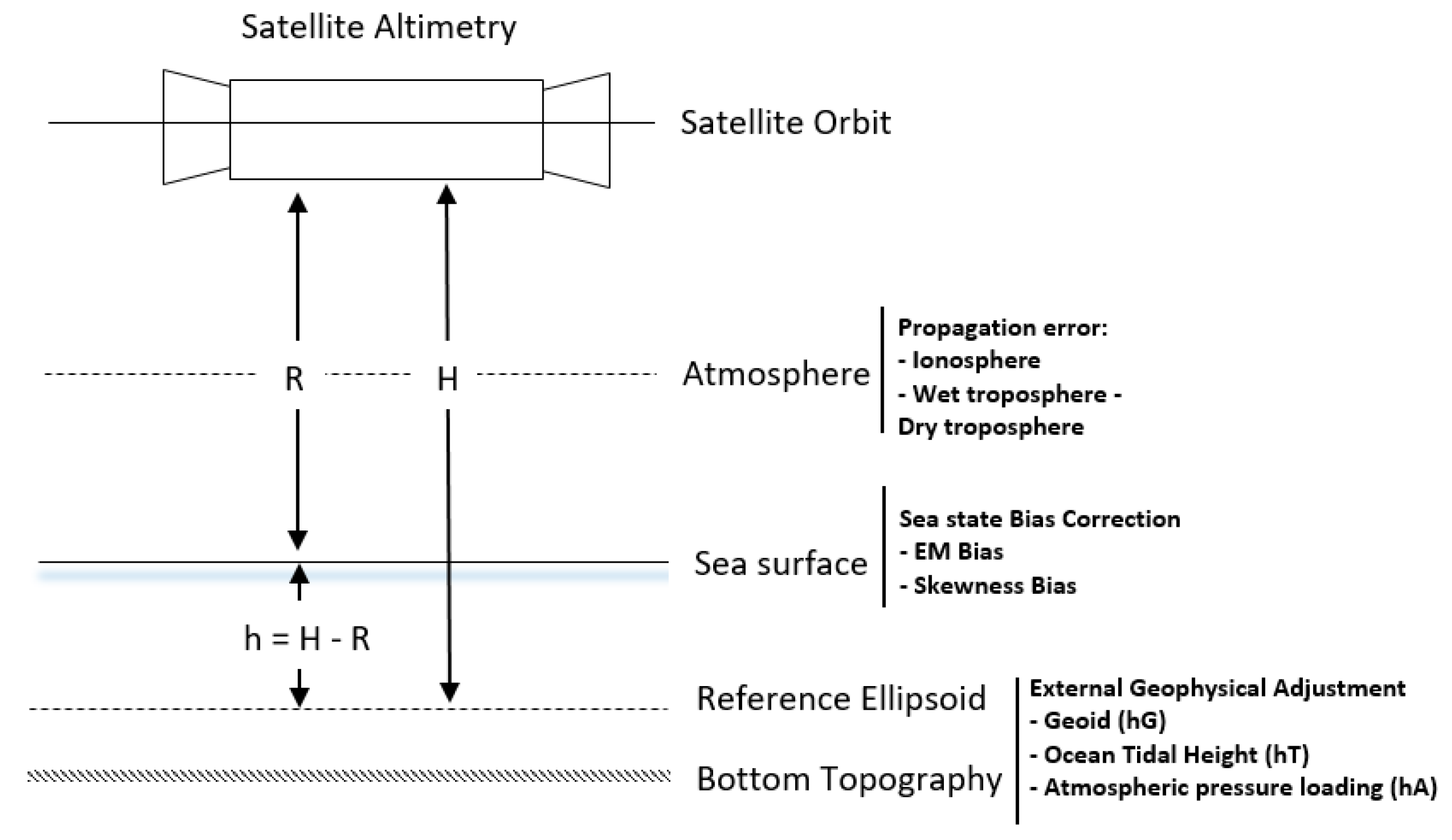
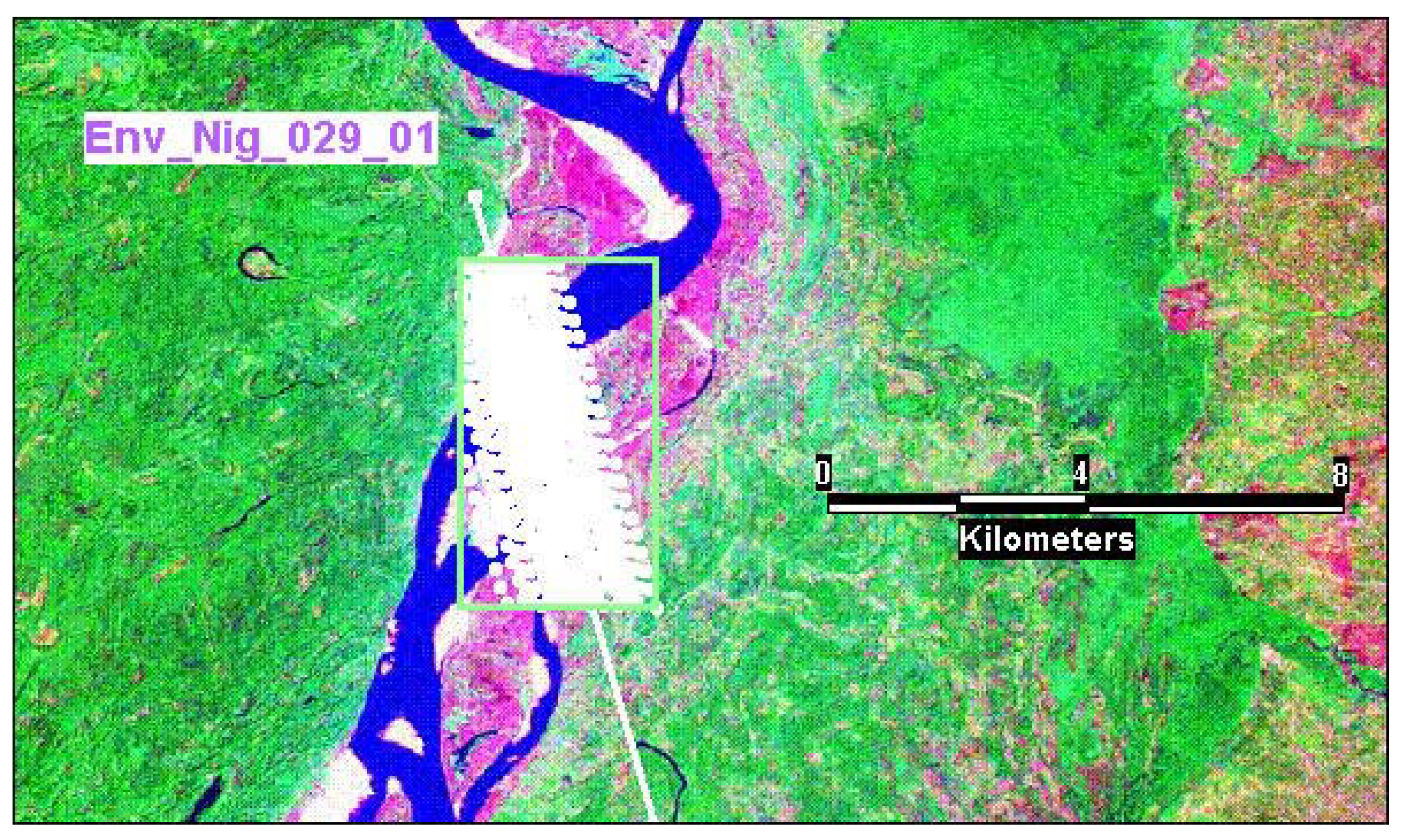

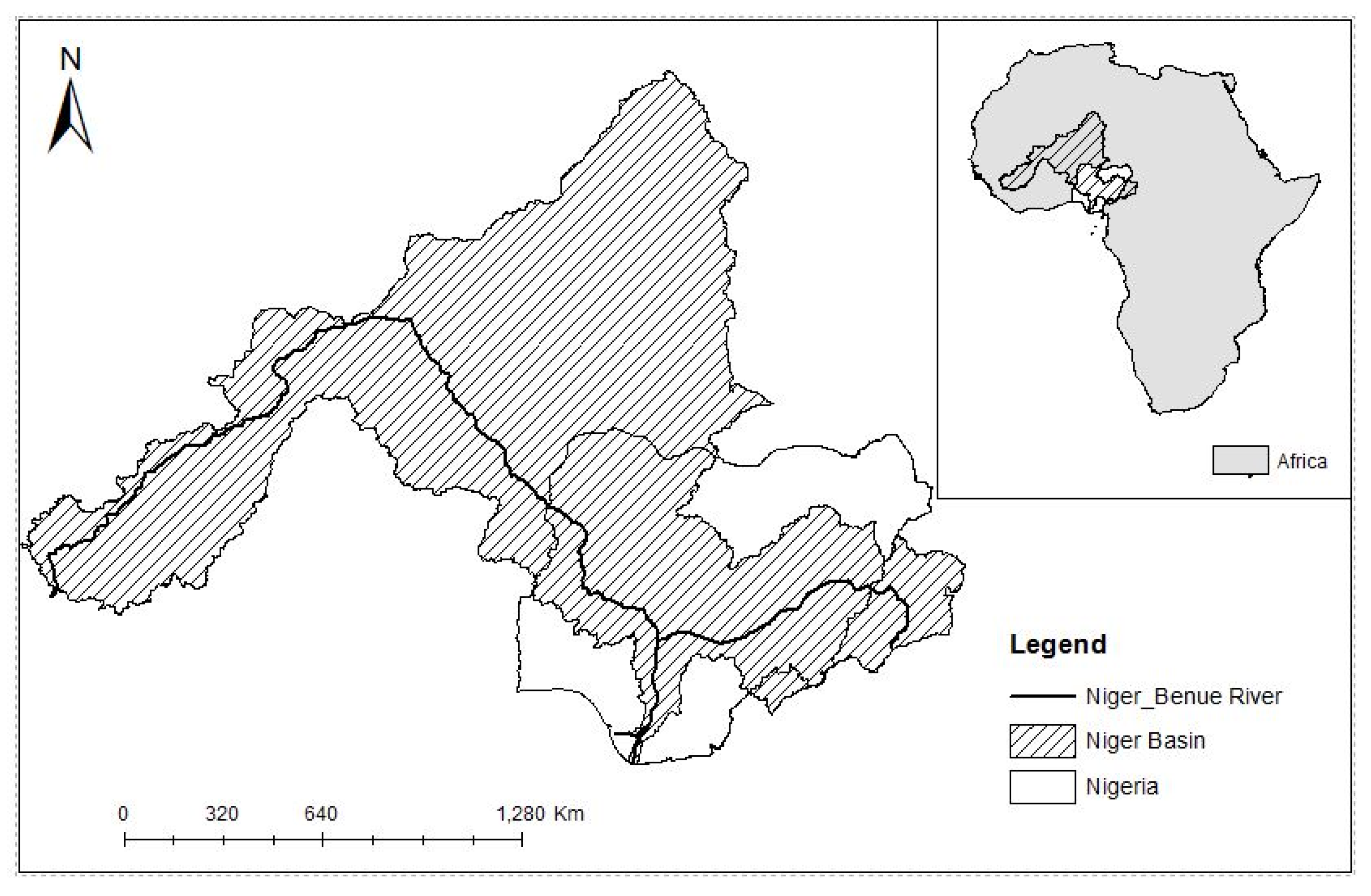
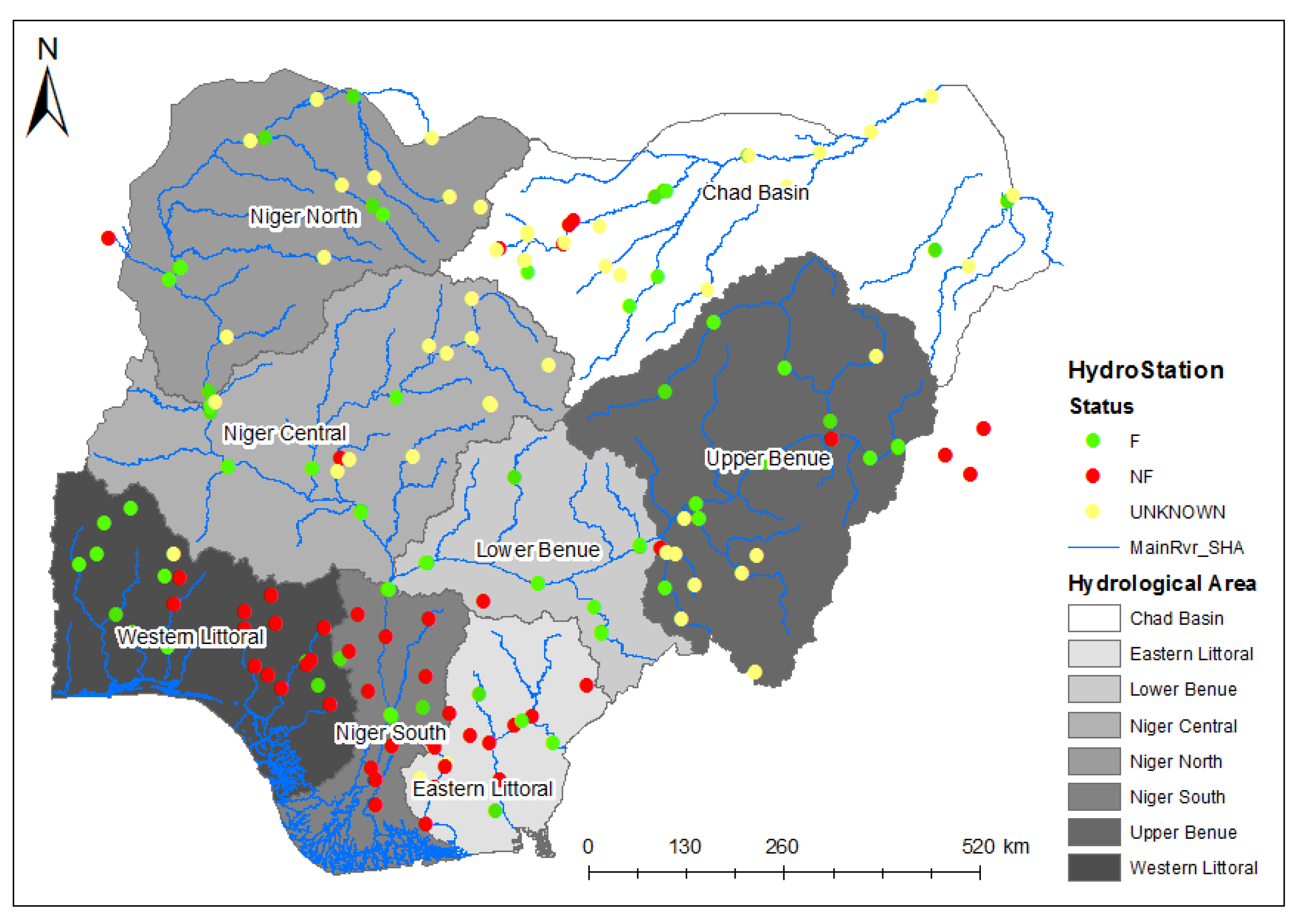
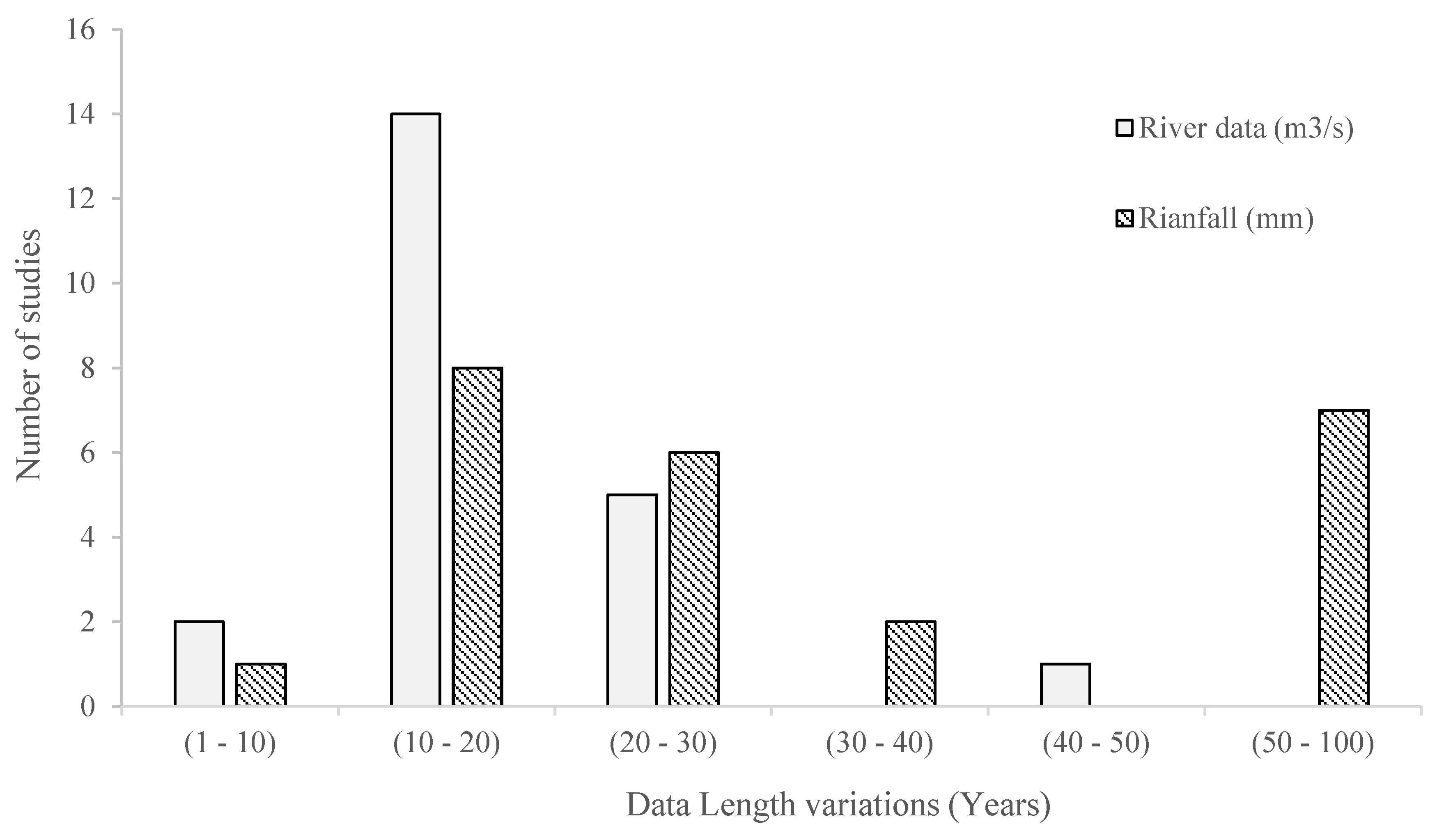

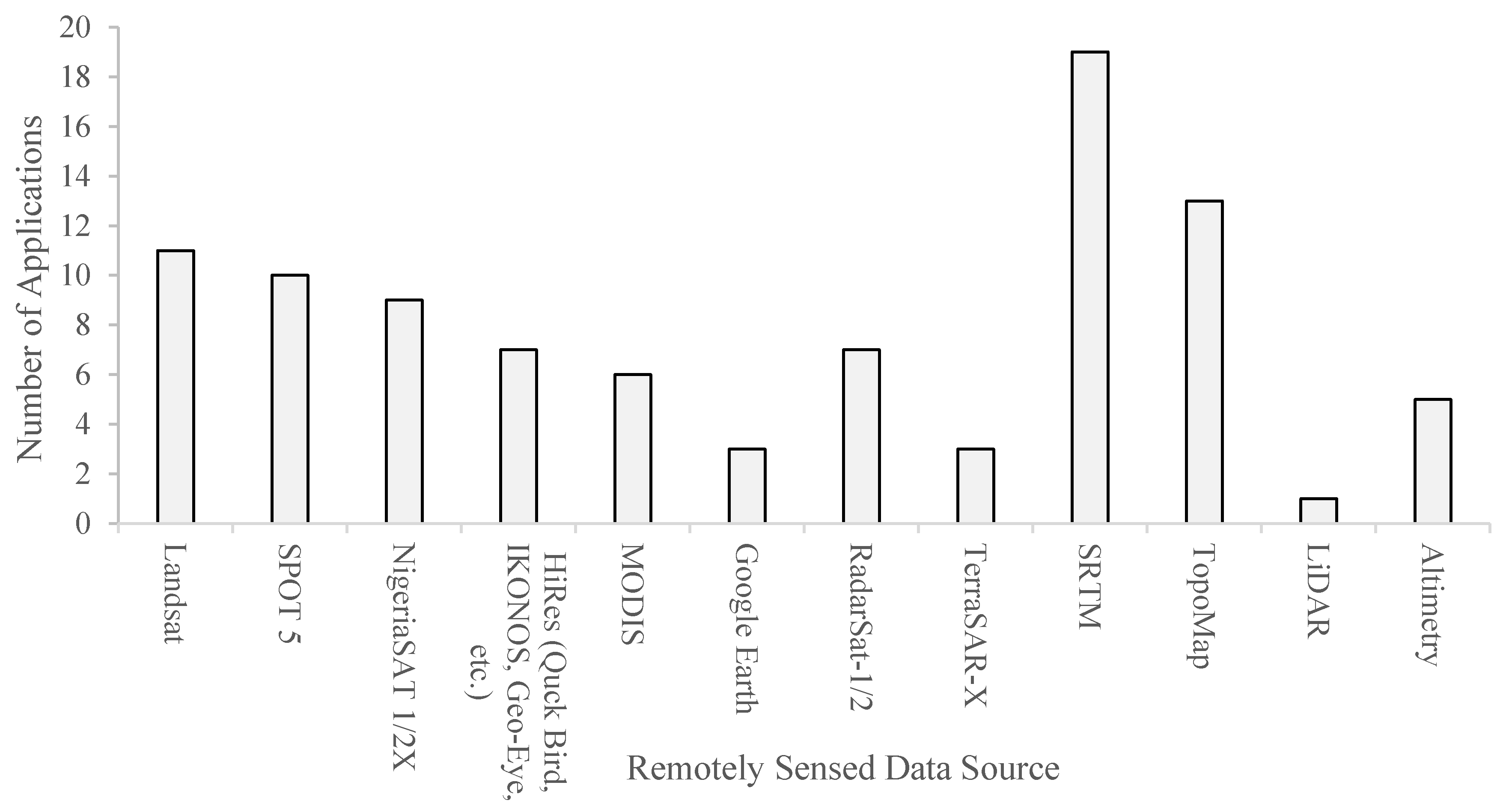
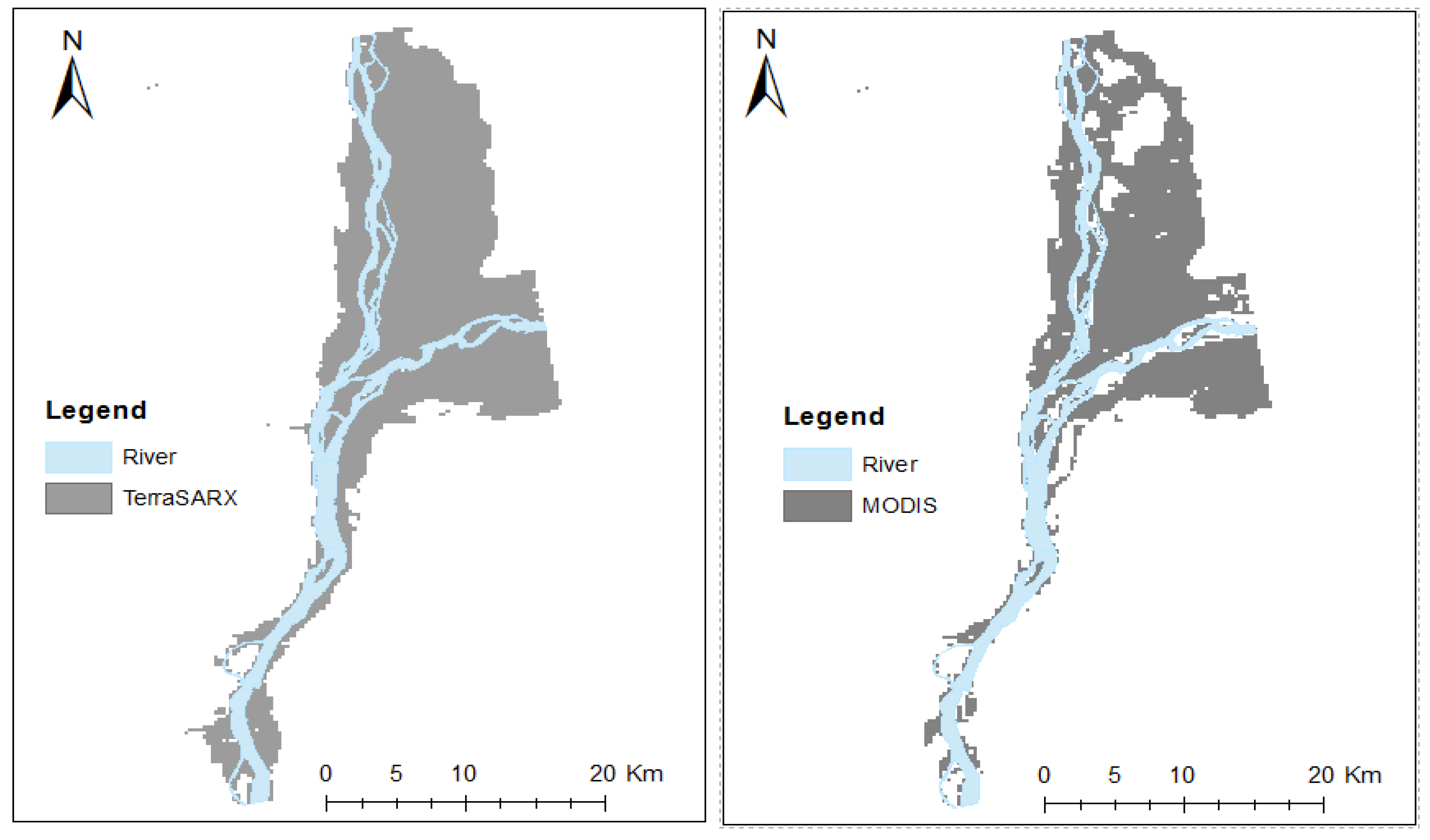
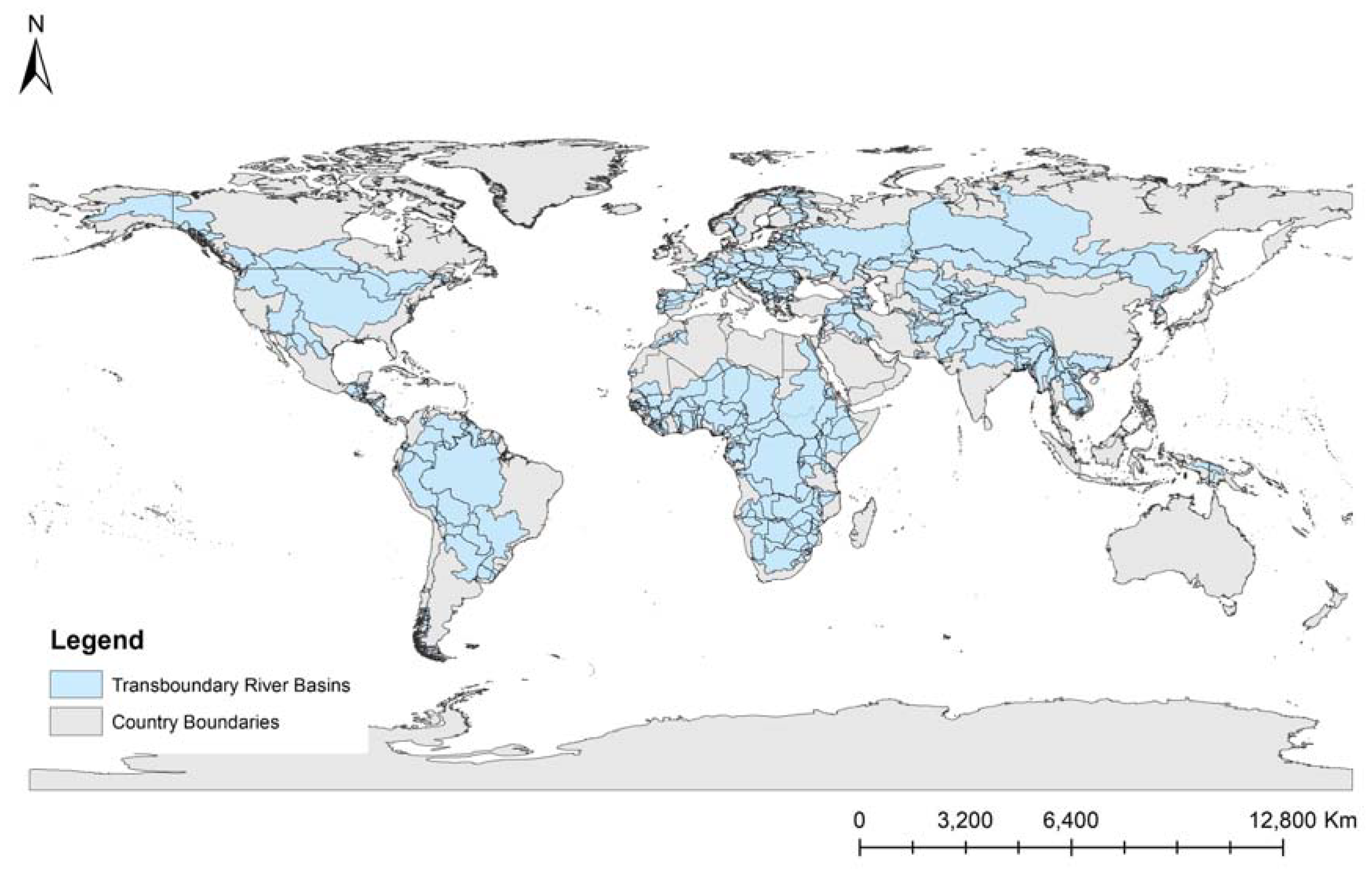
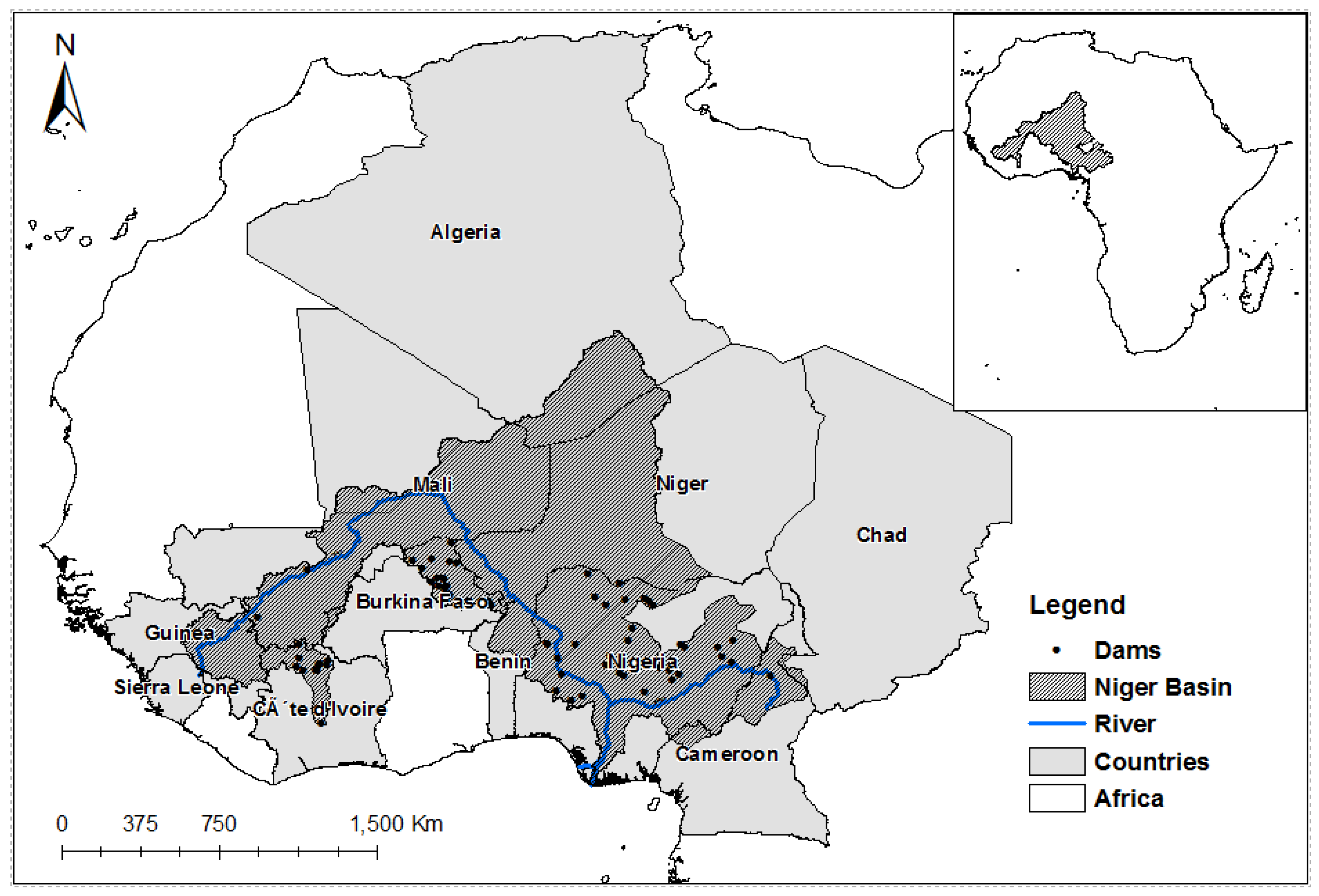



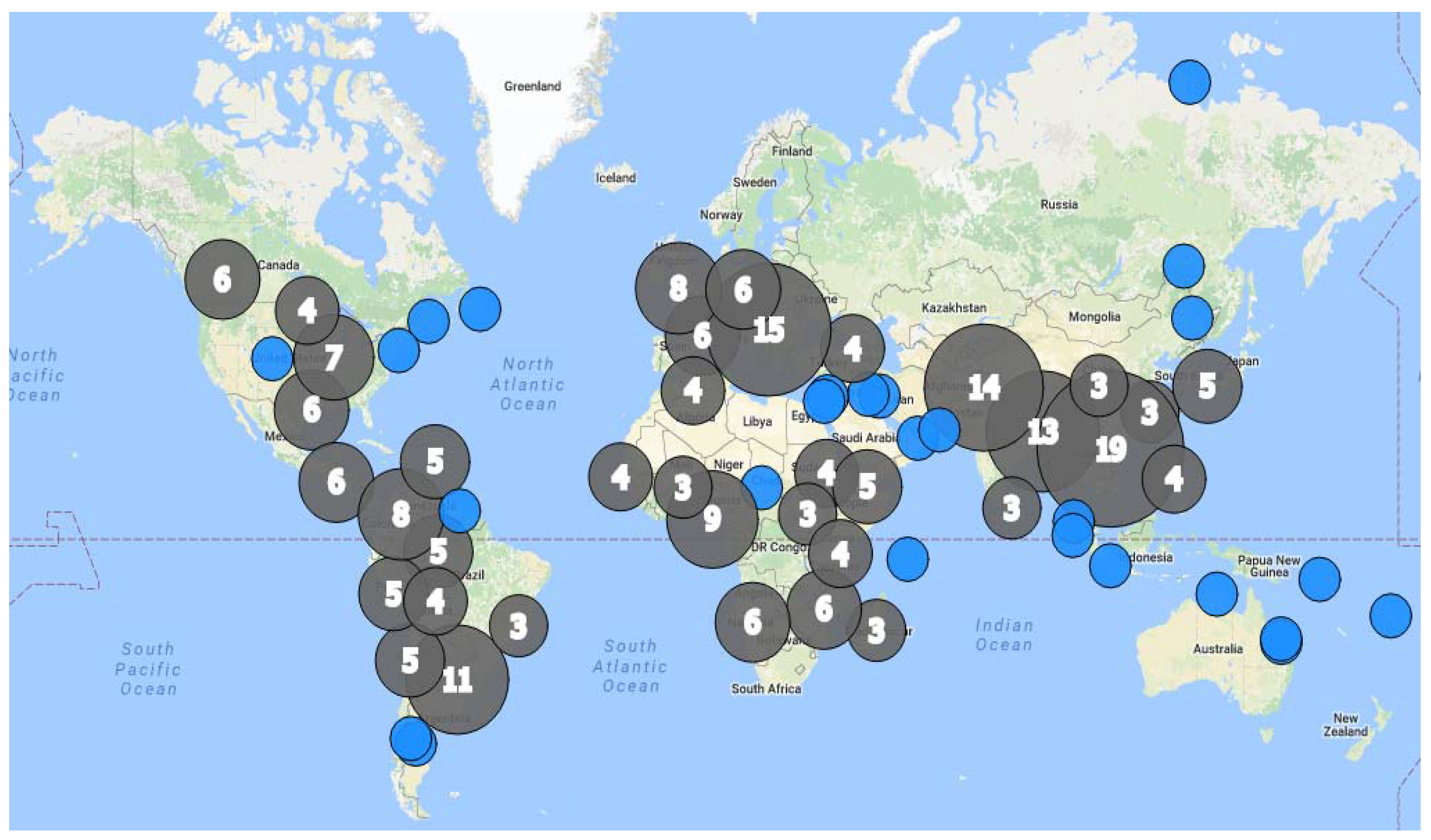
| Process | Data | Outcomes | Reference Case Studies |
|---|---|---|---|
| Flood frequency estimation | Historical data: River discharge, water levels and rating curves/equations. | Flood magnitude at specific return periods (Direct and regional). | [12,13,14,15] |
| Hydrodynamic modelling | Flood frequency outcome River discharge Digital elevation model Land use and cover map Historical flood extent, and marks. | Inundation Extent Water depth Flood velocity and travel time | [16,17,18,19] |
| Flood risk and vulnerability assessment | Hydrodynamic model outcomes, demographic, socio-economic and infrastructure data. | Exposure maps Vulnerability maps Evacuation plan | [19,20,21] |
| S/N | Mission | Ground Footprint (m) | Revisit Time (days) | Operation Timeline | Accuracy (m) | References |
|---|---|---|---|---|---|---|
| 1 | TOPEX/Poseidon | ~600 | 9.9 | 1993–2003 | 0.35 | [46] |
| 2 | ERS-1 | ~5000 | 35 | 1991–2000 | N/A | [36] |
| 3 | ERS-2 | ~400 | 35 | 1995–2003 | 0.55 | [46] |
| 4 | ENVISAT | ~400 | 35 | 2002–2012 | 0.28 | [46] |
| 5 | Jason-1 | ~300 | 10 | 2002–2009 | 1.07 | [52] |
| 6 | ICE Sat/GLAS | ~70 | - | 2003–2009 | 0.10 | [53] |
| 7 | Cyrosat-2 | ~300 | 369 | 2010 * | <SRTM (30) | [54] |
| 8 | Jason-2 | ~300 | 10 | 2008 * | 0.28 | [52] |
| 9 | SARAL/Altika | ~173 | 35 | 2013 * | 0.11 | [55] |
| 10 | Sentinel 3 SRAL | ~300 | 27 | 2016 * | 0.03 | [36] |
| 11 | Jason-3 | ~300 | 10 | 2016 * | 0.03 | [56] |
| 12 | SWOT | ~10–70 | 21 | 2020 + | 0.10 | [57] |
| DEM | Spatial Resolution (m) | Vertical Error (m) | Case Study | Reference |
|---|---|---|---|---|
| SRTM | 30, 90 | ±16 | Damoda River, India. | [69,125] |
| ASTER GDEM | 30 | ±25 | Lake Tana, Ethiopia. | [126,127] |
| ACE 2 GDEM | 1000 | >10 | Balkan Peninsula, Croatia | [128] |
| GTOPO30 | 1000 | 9–30 | Balkan Peninsula, Croatia | [128] |
| ALOS | 30 | ±5 | Sindh and Balochistan, Pakistan | [120,129] |
| GMTED2010 | 250 | 26–30 | Shikoku, Japan. | [130,131] |
| DEM | Spatial Resolution (m) | Vertical Error (m) | Case Study | Reference |
|---|---|---|---|---|
| Bare-Earth SRTM (Veg/Urban) | 90 | 6.05–12.64 | Belize, Honduras | [86] |
| Bare-Earth SRTM (Veg) | 90 | 4.85–8.667 | Global | [87] |
| EarthEnv-DEM90 | 90 | 4.13–10.55 | Johor River Basin, Malaysia | [141,142] |
| MERIT DEM | 90 | ±2 | Nile Basin, Congo and Ob rivers | [140] |
| Elevation | Min | Max | Mean | Std. Dev. | R2 | RMSE |
|---|---|---|---|---|---|---|
| Bare-Earth SRTM (Urban and Veg) | −3.89 | 151.00 | 29.65 | 37.66 | 0.99 | 3.21 |
| Bare-Earth SRTM (Veg) | 0.35 | 151.18 | 29.72 | 37.72 | 0.99 | 2.96 |
| EarthEnv90 | 3.00 | 152.00 | 30.95 | 37.45 | 0.99 | 3.76 |
| MERIT DEM | −1.27 | 148.44 | 28.96 | 37.71 | 0.99 | 3.68 |
| Raw-SRTM | 2.00 | 153.00 | 30.33 | 37.48 | 0.99 | 3.27 |
| ICE Sat/GLAS | 0.30 | 148.35 | 30.28 | 37.64 | - | - |
| Sat. Imagery | Res. (m) | Case Study | References |
|---|---|---|---|
| Landsat | 30 | Floodplain inundation delineation for 2 and 1–dimensional model calibration and validation, Inner Niger and Missouri River, Nebraska, USA | [114,163] |
| MODIS | 200 | Hydrodynamic model calibration and validation. | [113,164] |
| Terra ASTER | 15 | Urban sprawl and flood management Dhaka, Bangladesh | [113,164] |
| Sentinel-1 | 10 | Sentinel-1 and Landsat-8 combination in mapping flooding at river Evros, Greece | [113,164] |
| Sentinel-2 | 10 | Water bodies delineation | [113,164] |
| S/N | Treaty | Function | Location | Year |
|---|---|---|---|---|
| 1 | Act regarding navigation and economic co-operation between the states of the Niger Basin. | Navigation and Joint management | Niamey, Niger | 1963 |
| 2 | Agreement concerning the River Niger Commission and the navigation and transport on the River Niger. | Navigation, Joint management, information exchange | Niamey, Niger | 1964 |
| 3 | Agreement Revising the Agreement Concerning the Niger River Commission and the Navigation and Transport on the River Niger. | Navigation, Joint management, information exchange | Niamey, Niger | 1973 |
| 4 | Convention Creating the Niger Basin Authority (NBA) | Water resource mgt. coordination | Faranah, Guinea | 1980 |
| 5 | Protocol relating to the Development Fund of the Niger Basin | Planning funds for NBA | Faranah, Guinea | 1982 |
| 6 | Agreement between Nigeria and Mali | Co-operation on water resource use in the Niger | - | 1988 |
| 7 | Agreement Nigeria and the Republic of Niger concerning the equitable sharing in the development, conservation and use of their common water resources | Environmental conservation and water resource management | Maiduguri | 1990 |
| 8 | Nigeria-Cameroon Protocol Agreement | Coordinate dam water release. | - | 2000 |
| 9 | Niger Basin Water Charter. | NBA review and update. | Niamey, Niger | 2008 |
| 10 | African Risk Capacity | Weather financial risk management | Pretoria, South Africa | 2012 |
| Type of Disaster | Number of Activations | Number of Reference Maps | Number of Delineation Maps |
|---|---|---|---|
| Earthquake | 9 | 83 | 31 |
| Flood | 71 | 358 | 692 |
| Forest fire, wildfire | 21 | 47 | 98 |
| Industrial accident | 5 | 12 | 3 |
| Other | 55 | 218 | 143 |
| Wind storm | 14 | 80 | 45 |
| Total | 175 | 798 | 1012 |
© 2018 by the authors. Licensee MDPI, Basel, Switzerland. This article is an open access article distributed under the terms and conditions of the Creative Commons Attribution (CC BY) license (http://creativecommons.org/licenses/by/4.0/).
Share and Cite
Ekeu-wei, I.T.; Blackburn, G.A. Applications of Open-Access Remotely Sensed Data for Flood Modelling and Mapping in Developing Regions. Hydrology 2018, 5, 39. https://doi.org/10.3390/hydrology5030039
Ekeu-wei IT, Blackburn GA. Applications of Open-Access Remotely Sensed Data for Flood Modelling and Mapping in Developing Regions. Hydrology. 2018; 5(3):39. https://doi.org/10.3390/hydrology5030039
Chicago/Turabian StyleEkeu-wei, Iguniwari Thomas, and George Alan Blackburn. 2018. "Applications of Open-Access Remotely Sensed Data for Flood Modelling and Mapping in Developing Regions" Hydrology 5, no. 3: 39. https://doi.org/10.3390/hydrology5030039
APA StyleEkeu-wei, I. T., & Blackburn, G. A. (2018). Applications of Open-Access Remotely Sensed Data for Flood Modelling and Mapping in Developing Regions. Hydrology, 5(3), 39. https://doi.org/10.3390/hydrology5030039





